A Review of Acoustic Impedance Matching Techniques for Piezoelectric Sensors and Transducers
Abstract
1. Introduction
1.1. Theory of Piezoelectricity and Vibration Modes
1.2. Piezoelectric Operating Modes and Sensitivity
1.3. Commonly Used Piezoelectric Materials as an Active Matching Layer
1.3.1. Piezoelectric Ceramics
1.3.2. Piezoelectric Polymers
1.3.3. Piezoelectric Composites
1.4. Theory of Acoustic Impedance Mismatch and Transducer Performance Parameters
2. Acoustic Matching Tools and Methods
2.1. Traditional Quarter Wavelength Matching Method
2.2. Transmission-Line Approach
2.2.1. Single and Multi-Layer Matching
2.2.2. Cascaded Layer Matching
2.3. Mass-Spring Approach
2.4. Wave Propagation Model
2.5. Backing Absorber
2.6. Degradation and Endurance
3. Special Acoustic Matching Layer Materials
3.1. Composites and Nanocomposites as a Passive Matching Layer
3.2. Acoustic Metamaterials and Metasurfaces
4. Acoustic Matching for Specific Transducer or Sensor Type
4.1. Very High-Frequency Ultrasonic Transducers
4.2. Piezoelectric Micromachined Ultrasonic Transducers
4.3. Air and Liquid Coupled Transducers
4.4. Phased Array Transducers
4.5. High-Temperature Ultrasound
4.6. Acoustic Filters
5. Acoustic Matching for Specific Applications
5.1. Biomedical Applications
5.1.1. Medical Imaging
5.1.2. Thermal Therapy
5.1.3. Dental
5.1.4. Opthalmic
5.1.5. Implants
5.2. Cavitation
6. Conclusions
Funding
Acknowledgments
Conflicts of Interest
References
- Win, K.K.; Wang, J.; Zhang, C.; Yang, R. Identification and Removal of Reverberation in Ultrasound Imaging. In Proceedings of the 2010 5th IEEE Conference on Industrial Electronics and Applications, Taichung, Taiwan, 15–17 June 2010; pp. 1675–1680. [Google Scholar]
- Scanlan, K.A. Sonographic artifacts and their origins. Am. J. Roentgenol. 1991, 156, 1267–1272. [Google Scholar] [CrossRef] [PubMed]
- Gibson, N.M.; Dudley, N.J.; Griffith, K. A computerised quality control testing system for B-mode ultrasound. Ultrasound Med. Biol. 2001, 27, 1697–1711. [Google Scholar] [CrossRef]
- Liang, Z.; Yan, C.-F.; Rtimi, S.; Bandara, J. Piezoelectric materials for catalytic/photocatalytic removal of pollutants: Recent advances and outlook. Appl. Catal. B Environ. 2019, 241, 256–269. [Google Scholar] [CrossRef]
- Sunar, M.; Rao, S.S. Recent advances in sensing and control of flexible structures via piezoelectric materials technology. Appl. Mech. Rev. 1999, 52, 1–16. [Google Scholar] [CrossRef]
- Hu, N.; Burgueño, R. Buckling-induced smart applications: Recent advances and trends. Smart Mater. Struct. 2015, 24, 63001. [Google Scholar] [CrossRef]
- Bent, A.A.; Pizzochero, A.E. Recent Advances in Active Fiber Composites for Structural Control. In Proceedings of the Smart Structures and Materials 2000: Industrial and Commercial Applications of Smart Structures Technologies, Newport Beach, CA, USA, 12 June 2000; Volume 3991. [Google Scholar]
- Benjeddou, A. Advances in hybrid active-passive vibration and noise control via piezoelectric and viscoelastic constrained layer treatments. J. Vib. Control 2001, 7, 565–602. [Google Scholar] [CrossRef]
- Moheimani, S.O.R. A survey of recent innovations in vibration damping and control using shunted piezoelectric transducers. IEEE Trans. Control Syst. Technol. 2003, 11, 482–494. [Google Scholar] [CrossRef]
- Jain, A.; Kumar, J.S.; Srikanth, S.; Rathod, V.T.; Roy Mahapatra, D. Sensitivity of polyvinylidene fluoride films to mechanical vibration modes and impact after optimizing stretching conditions. Polym. Eng. Sci. 2013, 53, 707–715. [Google Scholar] [CrossRef]
- Rathod, V.T.; Mahapatra, D.R.; Jain, A.; Gayathri, A. Characterization of a large-area PVDF thin film for electro-mechanical and ultrasonic sensing applications. Sensors Actuators A Phys. 2010, 163, 164–171. [Google Scholar] [CrossRef]
- Chakraborty, N.; Rathod, V.T.; Roy Mahapatra, D.; Gopalakrishnan, S. Guided wave based detection of damage in honeycomb core sandwich structures. NDT E Int. 2012, 49, 27–33. [Google Scholar] [CrossRef]
- Rathod, V.T.; Roy Mahapatra, D. Ultrasonic Lamb wave based monitoring of corrosion type of damage in plate using a circular array of piezoelectric transducers. NDT E Int. 2011, 44, 628–636. [Google Scholar] [CrossRef]
- Giridhara, G.; Rathod, V.T.; Naik, S.; Roy Mahapatra, D.; Gopalakrishnan, S. Rapid localization of damage using a circular sensor array and Lamb wave based triangulation. Mech. Syst. Signal Process. 2010, 24, 2929–2946. [Google Scholar] [CrossRef]
- Gruverman, A.; Kalinin, S.V. Piezoresponse force microscopy and recent advances in nanoscale studies of ferroelectrics. J. Mater. Sci. 2006, 41, 107–116. [Google Scholar] [CrossRef]
- Spanner, K.; Vorndran, S. Advances in Piezo-nanopositioning Technology. In Proceedings of the 2003 IEEE/ASME International Conference on Advanced Intelligent Mechatronics (AIM 2003), Kobe, Japan, 20–24 July 2003; Volume 2, pp. 1338–1343. [Google Scholar]
- Khoshnoud, F.; de Silva, C.W. Recent advances in MEMS sensor technology – biomedical applications. IEEE Instrum. Meas. Mag. 2012, 15, 8–14. [Google Scholar] [CrossRef]
- Eom, C.-B.; Trolier-McKinstry, S. Thin-film piezoelectric MEMS. MRS Bull. 2012, 37, 1007–1017. [Google Scholar] [CrossRef]
- Tadigadapa, S.; Mateti, K. Piezoelectric MEMS sensors: State-of-the-art and perspectives. Meas. Sci. Technol. 2009, 20, 092001. [Google Scholar] [CrossRef]
- Muralt, P. Recent progress in materials issues for piezoelectric MEMS. J. Am. Ceram. Soc. 2008, 91, 1385–1396. [Google Scholar] [CrossRef]
- Ekinci, K.L. Electromechanical transducers at the nanoscale: Actuation and sensing of motion in nanoelectromechanical systems (NEMS). Small 2005, 1, 786–797. [Google Scholar] [CrossRef]
- Kim, H.S.; Kim, J.-H.; Kim, J. A review of piezoelectric energy harvesting based on vibration. Int. J. Precis. Eng. Manuf. 2011, 12, 1129–1141. [Google Scholar] [CrossRef]
- Anton, S.R.; Sodano, H.A. A review of power harvesting using piezoelectric materials (2003–2006). Smart Mater. Struct. 2007, 16, R1. [Google Scholar] [CrossRef]
- Bauer, S.; Gerhard-Multhaupt, R.; Sessler, G.M. Ferroelectrets: Soft electroactive foams for transducers. Phys. Today 2004, 57, 37–43. [Google Scholar] [CrossRef]
- Saarimaki, E.; Paajanen, M.; Savijarvi, A.; Minkkinen, H.; Wegener, M.; Voronina, O.; Schulze, R.; Wirges, W.; Gerhard-Multhaupt, R. Novel heat durable electromechanical film: Processing for electromechanical and electret applications. IEEE Trans. Dielectr. Electr. Insul. 2006, 13, 963–972. [Google Scholar] [CrossRef]
- Ko, W.-C.; Tseng, C.-K.; Leu, I.-Y.; Wu, W.-J.; Lee, A.S.-Y.; Lee, C.-K. Use of 2-(6-mercaptohexyl) malonic acid to adjust the morphology and electret properties of cyclic olefin copolymer and its application to flexible loudspeakers. Smart Mater. Struct. 2010, 19, 55007. [Google Scholar] [CrossRef]
- Rathod, V.T.; Hiremath, S.R.; Roy Mahapatra, D. Strength and Fatigue Life Evaluation of Composite Laminate with Embedded Sensors. In Proceedings of the SPIE—The International Society for Optical Engineering, San Diego, CA, USA, 10 April 2014; Volume 9062. [Google Scholar]
- Feng, G.-H.; Tsai, M.-Y. Acoustic emission sensor with structure-enhanced sensing mechanism based on micro-embossed piezoelectric polymer. Sensors Actuators A Phys. 2010, 162, 100–106. [Google Scholar] [CrossRef]
- Zou, L.; Ge, C.; Wang, Z.J.; Cretu, E.; Li, X. Novel tactile sensor technology and smart tactile sensing systems: A review. Sensors (Basel) 2017, 17, 2653. [Google Scholar] [CrossRef]
- Tiwana, M.I.; Redmond, S.J.; Lovell, N.H. A review of tactile sensing technologies with applications in biomedical engineering. Sensors Actuators A Phys. 2012, 179, 17–31. [Google Scholar] [CrossRef]
- Lindahl, O.A.; Constantinou, C.E.; Eklund, A.; Murayama, Y.; Hallberg, P.; Omata, S. Tactile resonance sensors in medicine. J. Med. Eng. Technol. 2009, 33, 263–273. [Google Scholar] [CrossRef]
- Saadon, S.; Sidek, O. A review of vibration-based MEMS piezoelectric energy harvesters. Energy Convers. Manag. 2011, 52, 500–504. [Google Scholar] [CrossRef]
- Cook-Chennault, K.A.; Thambi, N.; Sastry, A.M. Powering MEMS portable devices--a review of non-regenerative and regenerative power supply systems with special emphasis on piezoelectric energy harvesting systems. Smart Mater. Struct. 2008, 17, 43001. [Google Scholar] [CrossRef]
- Jadidian, B.; Hagh, N.M.; Winder, A.A.; Safari, A. 25 MHz ultrasonic transducers with lead- free piezoceramic, 1-3 PZT fiber-epoxy composite, and PVDF polymer active elements. IEEE Trans. Ultrason. Ferroelectr. Freq. Control 2009, 56, 368–378. [Google Scholar] [CrossRef]
- Döring, J.; Bovtun, V.; Gaal, M.; Bartusch, J.; Erhard, A.; Kreutzbruck, M.; Yakymenko, Y. Piezoelectric and electrostrictive effects in ferroelectret ultrasonic transducers. J. Appl. Phys. 2012, 112, 84505. [Google Scholar] [CrossRef]
- Zhou, D.; Cheung, K.F.; Chen, Y.; Lau, S.T.; Zhou, Q.; Shung, K.K.; Luo, H.S.; Dai, J.; Chan, H.L.W. Fabrication and performance of endoscopic ultrasound radial arrays based on PMN-PT single crystal/epoxy 1-3 composite. IEEE Trans. Ultrason. Ferroelectr. Freq. Control 2011, 58, 477–484. [Google Scholar] [CrossRef] [PubMed]
- Liu, C.; Djuth, F.; Hu, C.; Chen, R.; Zhang, X.; Li, X.; Zhou, Q.; Shung, K. Micromachined High Frequency PMN-PT/Epoxy 1–3 Composite Ultrasonic Annular Arrays. In Proceedings of the 2010 IEEE International Ultrasonics Symposium, San Diego, CA, USA, 11–14 October 2010; pp. 658–661. [Google Scholar]
- Sun, P.; Wang, G.; Wu, D.; Zhu, B.; Hu, C.; Liu, C.; Djuth, F.T.; Zhou, Q.; Shung, K.K. High frequency PMN-PT 1-3 composite transducer for ultrasonic imaging application. Ferroelectrics 2010, 408, 120–128. [Google Scholar] [CrossRef]
- Rathod, V.T.; Roy Mahapatra, D. Ultrasonic Guided Wave Sensing Properties of PVDF Thin Film With Inter Digital Electrodes. In Proceedings of the SPIE - The International Society for Optical Engineering, San Diego, CA, USA, 10 April 2014; Volume 9062. [Google Scholar]
- Rathod, V.T.; Raju, G.; Udpa, L.; Udpa, S.; Deng, Y. Embedded Thin Film Sensors Based Multi-mode Guided Wave Filter. In Proceedings of the 2018 IEEE Sensors, New Delhi, India, 28–31 October 2018. [Google Scholar]
- Rathod, V.T.; Raju, G.; Udpa, L.; Udpa, S.; Deng, Y. Multimode guided wave extraction capabilities using embedded thin film sensors in a composite laminated beam. Sensors Actuators A Phys. 2020, 309, 112040. [Google Scholar] [CrossRef]
- Haertling, G.H. Ferroelectric ceramics: History and technology. J. Am. Ceram. Soc. 1999, 82, 797–818. [Google Scholar] [CrossRef]
- Dagdeviren, C.; Joe, P.; Tuzman, O.L.; Park, K.-I.; Lee, K.J.; Shi, Y.; Huang, Y.; Rogers, J.A. Recent progress in flexible and stretchable piezoelectric devices for mechanical energy harvesting, sensing and actuation. Extrem. Mech. Lett. 2016, 9, 269–281. [Google Scholar] [CrossRef]
- Look, D.C. Recent advances in ZnO materials and devices. Mater. Sci. Eng. B 2001, 80, 383–387. [Google Scholar] [CrossRef]
- Dias, C.J.; Igreja, R.; Marat-Mendes, R.; Inacio, P.; Marat-Mendes, J.N.; Das-Gupta, D.K. Recent advances in ceramic-polymer composite electrets. IEEE Trans. Dielectr. Electr. Insul. 2004, 11, 35–40. [Google Scholar] [CrossRef]
- Zheng, T.; Wu, J.; Xiao, D.; Zhu, J. Recent development in lead-free perovskite piezoelectric bulk materials. Prog. Mater. Sci. 2018, 98, 552–624. [Google Scholar] [CrossRef]
- Bauer, F.; Fousson, E.; Zhang, Q.M. Recent advances in highly electrostrictive P(VDF-TrFE-CFE) terpolymers. IEEE Trans. Dielectr. Electr. Insul. 2006, 13, 1149–1154. [Google Scholar] [CrossRef]
- Iannacci, J. Microsystem based Energy Harvesting (EH-MEMS): Powering pervasivity of the Internet of Things (IoT)—A review with focus on mechanical vibrations. J. King Saud Univ. Sci. 2019, 31, 66–74. [Google Scholar] [CrossRef]
- Baali, H.; Djelouat, H.; Amira, A.; Bensaali, F. Empowering technology enabled care using IoT and smart devices: A review. IEEE Sens. J. 2018, 18, 1790–1809. [Google Scholar] [CrossRef]
- Rossing, T. Introduction to Acoustics. In Springer Handbook of Acoustics; Rossing, T., Ed.; Springer: New York, NY, USA, 2007; pp. 1–6. [Google Scholar]
- Shung, K.K.; Zippuro, M. Ultrasonic transducers and arrays. IEEE Eng. Med. Biol. Mag. 1996, 15, 20–30. [Google Scholar] [CrossRef]
- Lockwood, G.R.; Turnball, D.H.; Christopher, D.A.; Foster, F.S. Beyond 30 MHz [applications of high-frequency ultrasound imaging]. IEEE Eng. Med. Biol. Mag. 1996, 15, 60–71. [Google Scholar] [CrossRef]
- Smith, W.A. Composite Piezoelectric Materials for Medical Ultrasonic Imaging Transducers—A Review. In Proceedings of the Sixth IEEE International Symposium on Applications of Ferroelectrics, Bethlehem, PA, USA, 8–11 June 1986; pp. 249–256. [Google Scholar]
- Callen, P.W. Ultrasonography in Obstetrics and Gynecology; Elsevier Health Sciences: Amsterdam, The Netherlands, 2011. [Google Scholar]
- Shung, K.K. Diagnostic Ultrasound: Imaging and Blood Flow Measurements; CRC Press: Boca Raton, FL, USA, 2015. [Google Scholar]
- Errico, C.; Pierre, J.; Pezet, S.; Desailly, Y.; Lenkei, Z.; Couture, O.; Tanter, M. Ultrafast ultrasound localization microscopy for deep super-resolution vascular imaging. Nature 2015, 527, 499–502. [Google Scholar] [CrossRef] [PubMed]
- Osmanski, B.-F.; Pezet, S.; Ricobaraza, A.; Lenkei, Z.; Tanter, M. Functional ultrasound imaging of intrinsic connectivity in the living rat brain with high spatiotemporal resolution. Nat. Commun. 2014, 5, 5023. [Google Scholar] [CrossRef]
- Viessmann, O.M.; Eckersley, R.J.; Christensen-Jeffries, K.; Tang, M.X.; Dunsby, C. Acoustic super-resolution with ultrasound and microbubbles. Phys. Med. Biol. 2013, 58, 6447–6458. [Google Scholar] [CrossRef]
- Macé, E.; Montaldo, G.; Cohen, I.; Baulac, M.; Fink, M.; Tanter, M. Functional ultrasound imaging of the brain. Nat. Methods 2011, 8, 662–664. [Google Scholar] [CrossRef]
- Dirk Böse, M.D.; von Birgelen, C.; Raimund Erbel, R. Intravascular ultrasound for the evaluation of therapies targeting coronary atherosclerosisa. J. Am. Coll. Cardiol. 2007, 49, 925–932. [Google Scholar] [CrossRef]
- Abou-Elkacem, L.; Bachawal, S.V.; Willmann, J.K. Ultrasound molecular imaging: Moving toward clinical translation. Eur. J. Radiol. 2015, 84, 1685–1693. [Google Scholar] [CrossRef]
- Ranade, S.S.; Woo, S.-H.; Dubin, A.E.; Moshourab, R.A.; Wetzel, C.; Petrus, M.; Mathur, J.; Bégay, V.; Coste, B.; Mainquist, J.; et al. Piezo2 is the major transducer of mechanical forces for touch sensation in mice. Nature 2014, 516, 121–125. [Google Scholar] [CrossRef]
- Lam, K.H.; Hsu, H.-S.; Li, Y.; Lee, C.; Lin, A.; Zhou, Q.; Kim, E.S.; Shung, K.K. Ultrahigh frequency lensless ultrasonic transducers for acoustic tweezers application. Biotechnol. Bioeng. 2013, 110, 881–886. [Google Scholar] [CrossRef] [PubMed]
- Khuri-Yakub, B.T. Scanning acoustic microscopy. Ultrasonics 1993, 31, 361–372. [Google Scholar] [CrossRef]
- Lee, J.; Lee, C.; Kim, H.H.; Jakob, A.; Lemor, R.; Teh, S.-Y.; Lee, A.; Shung, K.K. Targeted cell immobilization by ultrasound microbeam. Biotechnol. Bioeng. 2011, 108, 1643–1650. [Google Scholar] [CrossRef] [PubMed]
- Zhu, B.; Fei, C.; Wang, C.; Zhu, Y.; Yang, X.; Zheng, H.; Zhou, Q.; Shung, K.K. Self-focused AlScN film ultrasound transducer for individual cell manipulation. ACS Sensors 2017, 2, 172–177. [Google Scholar] [CrossRef] [PubMed]
- Shung, K.K.; Cannata, J.M.; Zhou, Q.F. Piezoelectric materials for high frequency medical imaging applications: A review. J. Electroceramics 2007, 19, 141–147. [Google Scholar] [CrossRef]
- McKeighen, R.E. Design guidelines for medical ultrasonic arrays. In Proceedings of the SPIE, Medical Imaging 1998: Ultrasonic Transducer Engineering, San Diego, CA, USA, 1 May 1998; Volume 3341. [Google Scholar]
- Sinclair, A.N.; Chertov, A.M. Radiation endurance of piezoelectric ultrasonic transducers—A review. Ultrasonics 2015, 57, 1–10. [Google Scholar] [CrossRef]
- Rathod, V.T. Review of electric impedance matching techniques for piezoelectric sensors, actuators and transducers. Electronics 2019, 8, 169. [Google Scholar] [CrossRef]
- Desilets, C.S.; Fraser, J.D.; Kino, G.S. The design of efficient broad-band piezoelectric transducers. IEEE Trans. Sonics Ultrason. 1978, 25, 115–125. [Google Scholar] [CrossRef]
- Leo, D.J. Engineering Analysis of Smart Material Systems; John Wiley & Sons, Inc.: Hoboken, NJ, USA, 2007; pp. 1–23. [Google Scholar]
- Rathod, V.T.; Deng, Y. Structural Compatibility of Thin Film Sensors Embedded in a Composite Laminate. In Proceedings of the Active and Passive Smart Structures and Integrated Systems XIII, Denver, CO, USA, 21 March 2019; Volume 10967. [Google Scholar]
- Nix, E.L.; Ward, I.M. The measurement of the shear piezoelectric coefficients of polyvinylidene fluoride. Ferroelectrics 1986, 67, 137–141. [Google Scholar] [CrossRef]
- Rathod, V.T. Ultrasonic Guided Wave based Models, Devices and Methods for Integrated Structural Health Monitoring, Ph.D. Thesis, Indian Institute of Science, Bengaluru, India, 2014. [Google Scholar]
- Smith, W.A.; Shaulov, A.Y.; Auld, B.A. Tailoring the Properties of Composite Piezoelectric Materials for Medical Ultrasonic Transducers. In Proceedings of the IEEE 1985 Ultrasonics Symposium, San Francisco, CA, USA, 16–18 October 1985; pp. 642–647. [Google Scholar]
- Gallego-Juarez, J.A. Piezoelectric ceramics and ultrasonic transducers. J. Phys. E. Sci. Instrum. 1989, 22, 804–816. [Google Scholar] [CrossRef]
- Park, S.E.; Shrout, T.R. Characteristics of relaxor-based piezoelectric single crystals for ultrasonic transducers. IEEE Trans. Ultrason. Ferroelectr. Freq. Control 1997, 44, 1140–1147. [Google Scholar] [CrossRef]
- Park, S.E.; Shrout, T.R. Ultrahigh strain and piezoelectric behavior in relaxor based ferroelectric single crystals. J. Appl. Phys. 1997, 82, 1804–1811. [Google Scholar] [CrossRef]
- Umeda, K.; Kawai, H.; Honda, A.; Akiyama, M.; Kato, T.; Fukura, T. Piezoelectric properties of ScAlN thin films for piezo-MEMS devices. In Proceedings of the 2013 IEEE 26th International Conference on Micro Electro Mechanical Systems (MEMS), Taipei, Taiwan, 20–24 January 2013; pp. 733–736. [Google Scholar]
- Rathod, V.T.; Swamy, J.K.; Jain, A.; Mahapatra, D.R. Ultrasonic Lamb wave sensitivity of P(VDF–TrFE) thin films. ISSS J. Micro Smart Syst. 2018, 7, 35–43. [Google Scholar] [CrossRef]
- Baklouti, S.; Bouaziz, J.; Chartier, T.; Baumard, J.-F. Binder burnout and evolution of the mechanical strength of dry-pressed ceramics containing poly(vinyl alcohol). J. Eur. Ceram. Soc. 2001, 21, 1087–1092. [Google Scholar] [CrossRef]
- Takahiro, Y.; Masako, K.; Norikazu, S. Influence of poling conditions on the piezoelectric properties of PZT ceramics. J. Mater. Sci. Mater. Electron. 2000, 11, 425–428. [Google Scholar] [CrossRef]
- Jaffe, B.; Roth, R.S.; Marzullo, S. Piezoelectric properties of lead zirconate-lead titanate solid-solution ceramics. J. Appl. Phys. 1954, 25, 809–810. [Google Scholar] [CrossRef]
- Tressler, J.F.; Alkoy, S.; Newnham, R.E. Piezoelectric sensors and sensor materials. J. Electroceramics 1998, 2, 257–272. [Google Scholar] [CrossRef]
- Liu, C. Recent developments in polymer MEMS. Adv. Mater. 2007, 19, 3783–3790. [Google Scholar] [CrossRef]
- Maeder, M.D.; Damjanovic, D.; Setter, N. Lead free piezoelectric materials. J. Electroceramics 2004, 13, 385–392. [Google Scholar] [CrossRef]
- Aksel, E.; Jones, J.L. Advances in lead-free piezoelectric materials for sensors and actuators. Sensors 2010, 10, 1935–1954. [Google Scholar] [CrossRef] [PubMed]
- Panda, P.K. Review: Environmental friendly lead-free piezoelectric materials. J. Mater. Sci. 2009, 44, 5049–5062. [Google Scholar] [CrossRef]
- Safari, A.; Abazari, M. Lead-free piezoelectric ceramics and thin films. IEEE Trans. Ultrason. Ferroelectr. Freq. Control 2010, 57, 2165–2176. [Google Scholar] [CrossRef] [PubMed]
- Setter, N.; Damjanovic, D.; Eng, L.; Fox, G.; Gevorgian, S.; Hong, S.; Kingon, A.; Kohlstedt, H.; Park, N.Y.; Stephenson, G.B.; et al. Ferroelectric thin films: Review of materials, properties, and applications. J. Appl. Phys. 2006, 100, 51606. [Google Scholar] [CrossRef]
- Muralt, P.; Polcawich, R.G.; Trolier-McKinstry, S. Piezoelectric thin films for sensors, actuators, and energy harvesting. MRS Bull. 2009, 34, 658–664. [Google Scholar] [CrossRef]
- Rathod, V.T.; Mahapatra, D.R.; Jeyaseelan, A.A.; Dutta, S. Ultrasonic guided wave sensing characteristics of large area thin piezo coating. Smart Mater. Struct. 2017, 26, 105009. [Google Scholar] [CrossRef]
- Rathod, V.T.; Roy Mahapatra, D.; Jeyaseelan, A.; Dutta, S. Large-area Piezoceramic Coating with IDT Electrodes for Ultrasonic Sensing Applications. In Proceedings of the SPIE, San Diego, CA, USA, 11 April 2013; Volume 8693, p. 86930L. [Google Scholar]
- Hsu, H.-S.; Benjauthrit, V.; Zheng, F.; Chen, R.; Huang, Y.; Zhou, Q.; Shung, K.K. PMN-PT–PZT composite films for high frequency ultrasonic transducer applications. Sensors Actuators A Phys. 2012, 179, 121–124. [Google Scholar] [CrossRef]
- Kawai, H. The piezoelectricity of poly(vinylidene fluoride). Jpn. J. Appl. Phys. 1969, 8, 975–976. [Google Scholar] [CrossRef]
- Zhenyi, M.; Scheinbeim, J.I.; Lee, J.W.; Newman, B.A. High field electrostrictive response of polymers. J. Polym. Sci. Part B Polym. Phys. 1994, 32, 2721–2731. [Google Scholar] [CrossRef]
- Ohigashi, H.; Omote, K.; Gomyo, T. Formation of “single crystalline films” of ferroelectric copolymers of vinylidene fluoride and trifluoroethylene. Appl. Phys. Lett. 1995, 66, 3281–3283. [Google Scholar] [CrossRef]
- Lang, S.B.I. Bibliography on piezoelectricity and pyroelectricity of polymers 1961–1980. Ferroelectrics 1981, 32, 191–245. [Google Scholar] [CrossRef]
- Foster, F.S.; Harasiewicz, K.A.; Sherar, M.D. A history of medical and biological imaging with polyvinylidene fluoride (PVDF) transducers. IEEE Trans. Ultrason. Ferroelectr. Freq. Control 2000, 47, 1363–1371. [Google Scholar] [CrossRef]
- Chen, Q.X.; Payne, P.A. Industrial applications of piezoelectric polymer transducers. Meas. Sci. Technol. 1995, 6, 249–267. [Google Scholar] [CrossRef]
- Hooker, M.W. Properties of PZT-Based Piezoelectric Ceramics between −150 and 250 °C; NASA/: CR-1998-208708; National Aeronautics and Space Administration: Langley Research Center: Hampton, VA, USA, 1998.
- Bowen, L.; Gentilman, R.; Fiore, D.; Pham, H.; Serwatka, W.; Near, C.; Pazol, B. Design, fabrication, and properties of sonopanelTM 1–3 piezocomposite transducers. Ferroelectrics 1996, 187, 109–120. [Google Scholar] [CrossRef]
- Siemann, U. Solvent cast technology - a versatile tool for thin film production. In Scattering Methods and the Properties of Polymer Materials; Stribeck, N., Smarsly, B., Eds.; Springer Berlin Heidelberg: Berlin, Heidelberg, 2005; pp. 1–14. [Google Scholar]
- Mhalgi, M.V.; Khakhar, D.V.; Misra, A. Stretching induced phase transformations in melt extruded poly(vinylidene fluoride) cast films: Effect of cast roll temperature and speed. Polym. Eng. Sci. 2007, 47, 1992–2004. [Google Scholar] [CrossRef]
- Becker, H.; Gärtner, C. Polymer microfabrication technologies for microfluidic systems. Anal. Bioanal. Chem. 2008, 390, 89–111. [Google Scholar] [CrossRef] [PubMed]
- Gregorio Jr., R.; Ueno, E.M. Effect of crystalline phase, orientation and temperature on the dielectric properties of poly (vinylidene fluoride) (PVDF). J. Mater. Sci. 1999, 34, 4489–4500. [Google Scholar] [CrossRef]
- Inderherbergh, J. Polyvinylidene fluoride (PVDF) appearance, general properties and processing. Ferroelectrics 1991, 115, 295–302. [Google Scholar] [CrossRef]
- Jayasuriya, A.C.; Schirokauer, A.; Scheinbeim, J.I. Crystal-structure dependence of electroactive properties in differently prepared poly(vinylidene fluoride/hexafluoropropylene) copolymer films. J. Polym. Sci. Part B Polym. Phys. 2001, 39, 2793–2799. [Google Scholar] [CrossRef]
- He, X.; Yao, K.; Gan, B.K. Ferroelectric poly(vinylidene fluoride-hexafluoropropylene) thin films on silicon substrates. Sensors Actuators A Phys. 2007, 139, 158–161. [Google Scholar] [CrossRef]
- Vijayakumar, R.P.; Khakhar, D.V.; Misra, A. Studies on α to β phase transformations in mechanically deformed PVDF films. J. Appl. Polym. Sci. 2010, 117, 3491–3497. [Google Scholar]
- Gregorio Jr., R. Determination of the α, β, and γ crystalline phases of poly(vinylidene fluoride) films prepared at different conditions. J. Appl. Polym. Sci. 2006, 100, 3272–3279. [Google Scholar] [CrossRef]
- Sessler, G.M. Piezoelectricity in polyvinylidenefluoride. J. Acoust. Soc. Am. 1981, 70, 1596–1608. [Google Scholar] [CrossRef]
- Kaura, T.; Nath, R.; Perlman, M.M. Simultaneous stretching and corona poling of PVDF films. J. Phys. D. Appl. Phys. 1991, 24, 1848–1852. [Google Scholar] [CrossRef]
- Hadji, R.; Nguyen, V.S.; Vincent, B.; Rouxel, D.; Bauer, F. Preparation and characterization of P(VDF-TrFE)/Al2O3 nanocomposite. IEEE Trans. Ultrason. Ferroelectr. Freq. Control 2012, 59, 163–167. [Google Scholar] [CrossRef] [PubMed]
- Harrison, J.S.; Ounaies, Z. Piezoelectric Polymers. In Encyclopedia of Polymer Science and Technology; John Wiley & Sons Inc.: Hoboken, NJ, USA, 2002. [Google Scholar]
- Fukada, E. History and recent progress in piezoelectric polymers. IEEE Trans. Ultrason. Ferroelectr. Freq. Control 2000, 47, 1277–1290. [Google Scholar] [CrossRef]
- Varadan, V.V.; Roh, Y.R.; Varadan, V.K.; Tancrell, R.H. Measurement of all the Elastic and Dielectric Constants of Poled PVDF Films. In Proceedings of the IEEE Ultrasonics Symposium, Montreal, QC, Canada, 3–6 October 1989; Volume 2, pp. 727–730. [Google Scholar]
- Schewe, H. Piezoelectricity of Uniaxially Oriented Polyvinylidene Fluoride. In Proceedings of the 1982 Ultrasonics Symposium, San Diego, CA, USA, 27–29 October 1982; pp. 519–524. [Google Scholar]
- Wang, H.; Zhang, Q.M.; Cross, L.E.; Sykes, A.O. Piezoelectric, dielectric, and elastic properties of poly(vinylidene fluoride/trifluoroethylene). J. Appl. Phys. 1993, 74, 3394–3398. [Google Scholar] [CrossRef]
- Ramadan, K.S.; Sameoto, D.; Evoy, S. A review of piezoelectric polymers as functional materials for electromechanical transducers. Smart Mater. Struct. 2014, 23, 33001. [Google Scholar] [CrossRef]
- Rathod, V.T.; Roy Mahapatra, D.; Jain, A.; Gayathri, A. Ultrasonic Performance of the PVDF Thin Film Sensors Under Thermal Fatigue. In Proceedings of the SPIE, San Diego, CA, USA, 28 March 2012; Volume 8342. [Google Scholar]
- Rathod, V.T.; Jain, A. Ultrasonic guided wave sensitivity of piezopolymer films subjected to thermal exposure. ISSS J. Micro Smart Syst. 2018, 7, 15–24. [Google Scholar] [CrossRef]
- Klicker, K.A.; Biggers, J.V.; Newnham, R.E. Composites of PZT and epoxy for hydrostatic transducer applications. J. Am. Ceram. Soc. 1981, 64, 5–9. [Google Scholar] [CrossRef]
- Safari, A.; Janas, V.F.; Bandyopadhyay, A. Development of fine-scale piezoelectric composites for transducers. AIChE J. 1997, 43, 2849–2856. [Google Scholar] [CrossRef]
- Chapelon, J.-Y.; Cathignol, D.; Cain, C.; Ebbini, E.; Kluiwstra, J.-U.; Sapozhnikov, O.A.; Fleury, G.; Berriet, R.; Chupin, L.; Guey, J.-L. New piezoelectric transducers for therapeutic ultrasound. Ultrasound Med. Biol. 2000, 26, 153–159. [Google Scholar] [CrossRef]
- Pilgrim, S.M.; Newnham, R.E.; Rohlfing, L.L. An extension of the composite nomenclature scheme. Mater. Res. Bull. 1987, 22, 677–684. [Google Scholar] [CrossRef]
- Newnham, R.E.; Skinner, D.P.; Cross, L.E. Connectivity and piezoelectric-pyroelectric composites. Mater. Res. Bull. 1978, 13, 525–536. [Google Scholar] [CrossRef]
- Levassort, F.; Lethiecq, M.; Desmare, R.; Hue, T.H. Effective electroelastic moduli of 3-3(0-3) piezocomposites. IEEE Trans. Ultrason. Ferroelectr. Freq. Control 1999, 46, 1028–1034. [Google Scholar] [CrossRef] [PubMed]
- Newnham, R.E. Composite electroceramics. Ferroelectrics 1986, 68, 1–32. [Google Scholar] [CrossRef]
- Halloran, J.W. Freeform fabrication of ceramics. Br. Ceram. Trans. 1999, 98, 299–303. [Google Scholar] [CrossRef]
- Smith, W.A. The role of Piezocomposites in Ultrasonic Transducers. In Proceedings of the IEEE Ultrasonics Symposium, Montreal, QC, Canada, 3-6 October 1989; Volume 2, pp. 755–766. [Google Scholar]
- Akdogan, E.K.; Allahverdi, M.; Safari, A. Piezoelectric composites for sensor and actuator applications. IEEE Trans. Ultrason. Ferroelectr. Freq. Control 2005, 52, 746–775. [Google Scholar] [CrossRef] [PubMed]
- Prashanthi, K.; Naresh, M.; Seena, V.; Thundat, T.; Ramgopal Rao, V. A novel photoplastic piezoelectric nanocomposite for MEMS applications. J. Microelectromechanical Syst. 2012, 21, 259–261. [Google Scholar] [CrossRef]
- Badcock, R.A.; Birt, E.A. The use of 0-3 piezocomposite embedded Lamb wave sensors for detection of damage in advanced fibre composites. Smart Mater. Struct. 2000, 9, 291–297. [Google Scholar] [CrossRef]
- Egusa, S.; Iwasawa, N. Piezoelectric paints as one approach to smart structural materials with health-monitoring capabilities. Smart Mater. Struct. 1998, 7, 438–445. [Google Scholar] [CrossRef]
- Bent, A.A.; Hagood, N.W. Piezoelectric fiber composites with interdigitated electrodes. J. Intell. Mater. Syst. Struct. 1997, 8, 903–919. [Google Scholar] [CrossRef]
- Wilkie, W.K.; Bryant, R.G.; High, J.W.; Fox, R.L.; Hellbaum, R.F.; Jalink Jr., A.; Little, B.D.; Mirick, P.H. Low-cost Piezocomposite Actuator for Structural Control Applications. In Proceedings of the SPIE, Newport Beach, CA, USA, 12 June 2000; Volume 3991. [Google Scholar]
- Lees, S.; Davidson, C.L. Ultrasonic measurement of some mineral filled plastics. IEEE Trans. Sonics Ultrason. 1977, 24, 222–225. [Google Scholar] [CrossRef]
- Gururaja, T.R.; Schulze, W.A.; Cross, L.E.; Newnham, R.E.; Auld, B.A.; Wang, Y.J. Piezoelectric composite materials for ultrasonic transducer applications. Part I: Resonant modes of vibration of PZT rod-polymer composites. IEEE Trans. Sonics Ultrason. 1985, 32, 481–498. [Google Scholar] [CrossRef]
- Smith, W.A.; Auld, B.A. Modeling 1-3 composite piezoelectrics: Thickness-mode oscillations. IEEE Trans. Ultrason. Ferroelectr. Freq. Control 1991, 38, 40–47. [Google Scholar] [CrossRef] [PubMed]
- Guinovart-Dıaz, R.; Bravo-Castillero, J.; Rodrıguez-Ramos, R.; Sabina, F.J.; Martınez-Rosado, R. Overall properties of piezocomposite materials 1–3. Mater. Lett. 2001, 48, 93–98. [Google Scholar] [CrossRef]
- Kar-Gupta, R.; Venkatesh, T.A. Electromechanical response of 1–3 piezoelectric composites: An analytical model. Acta Mater. 2007, 55, 1093–1108. [Google Scholar] [CrossRef]
- Geng, X.; Zhang, Q.M. Evaluation of piezocomposites for ultrasonic transducer applications influence of the unit cell dimensions and the properties of constituents on the performance of 2-2 piezocomposites. IEEE Trans. Ultrason. Ferroelectr. Freq. Control 1997, 44, 857–872. [Google Scholar] [CrossRef]
- Hossack, J.A.; Hayward, G. Finite-element analysis of 1-3 composite transducers. IEEE Trans. Ultrason. Ferroelectr. Freq. Control 1991, 38, 618–629. [Google Scholar] [CrossRef]
- Park, K.-I.; Lee, M.; Liu, Y.; Moon, S.; Hwang, G.-T.; Zhu, G.; Kim, J.E.; Kim, S.O.; Kim, D.K.; Wang, Z.L.; et al. Flexible nanocomposite generator made of BaTiO3 nanoparticles and graphitic carbons. Adv. Mater. 2012, 24, 2999–3004. [Google Scholar] [CrossRef]
- Gururaja, T.R.; Schulze, W.A.; Shrout, T.R.; Safari, A.; Webster, L.; Cross, L.E. High frequency applications of PZT/polymer composite materials. Ferroelectrics 1981, 39, 1245–1248. [Google Scholar] [CrossRef]
- Matt, H.M.; di Scalea, F.L. Macro-fiber composite piezoelectric rosettes for acoustic source location in complex structures. Smart Mater. Struct. 2007, 16, 1489–1499. [Google Scholar] [CrossRef]
- Yang, Y.; Tang, L.; Li, H. Vibration energy harvesting using macro-fiber composites. Smart Mater. Struct. 2009, 18, 115025. [Google Scholar] [CrossRef]
- Zhang, Y.; Wang, S.; Liu, D.; Zhang, Q.; Wang, W.; Ren, B.; Zhao, X.; Luo, H. Fabrication of angle beam two-element ultrasonic transducers with PMN–PT single crystal and PMN–PT/epoxy 1–3 composite for NDE applications. Sensors Actuators A Phys. 2011, 168, 223–228. [Google Scholar] [CrossRef]
- Rittenmyer, K.; Shrout, T.; Schulze, W.A.; Newnham, R.E. Piezoelectric 3–3 composites. Ferroelectrics 1982, 41, 189–195. [Google Scholar] [CrossRef]
- Safari, A.; Newnham, R.E.; Cross, L.E.; Schulze, W.A. Perforated PZT-polymer composites for piezoelectric transducer applications. Ferroelectrics 1982, 41, 197–205. [Google Scholar] [CrossRef]
- Zhang, Q.M.; Chen, J.; Wang, H.; Zhao, J.; Cross, L.E.; Trottier, M.C. A new transverse piezoelectric mode 2-2 piezocomposite for underwater transducer applications. IEEE Trans. Ultrason. Ferroelectr. Freq. Control 1995, 42, 774–781. [Google Scholar] [CrossRef]
- Fei, C.; Ma, J.; Chiu, C.T.; Williams, J.A.; Fong, W.; Chen, Z.; Zhu, B.; Xiong, R.; Shi, J.; Hsiai, T.K.; et al. Design of matching layers for high-frequency ultrasonic transducers. Appl. Phys. Lett. 2015, 107, 123505. [Google Scholar] [CrossRef]
- Song, S.H.; Kim, A.; Ziaie, B. Omnidirectional ultrasonic powering for millimeter-scale implantable devices. IEEE Trans. Biomed. Eng. 2015, 62, 2717–2723. [Google Scholar] [CrossRef]
- Crecraft, D.I. Ultrasonic instrumentation: Principles, methods and applications. J. Phys. E: Sci. Instrum. 1983, 16, 181–189. [Google Scholar] [CrossRef]
- Fang, H.J.; Chen, Y.; Wong, C.M.; Qiu, W.B.; Chan, H.L.W.; Dai, J.Y.; Li, Q.; Yan, Q.F. Anodic aluminum oxide–epoxy composite acoustic matching layers for ultrasonic transducer application. Ultrasonics 2016, 70, 29–33. [Google Scholar] [CrossRef]
- Amoroso, L.; Ramadas, S.N.; Klieber, C.; Gomez Alvarez-Arenas, T.E.; McNally, T. Novel Nanocomposite Materials for Improving Passive Layers in Air-coupled Ultrasonic Transducer Applications. In Proceedings of the 2019 IEEE International Ultrasonics Symposium (IUS), Glasgow, UK, 6–9 October 2019; pp. 2608–2611. [Google Scholar]
- Lau, S.T.; Li, H.; Wong, K.S.; Zhou, Q.F.; Zhou, D.; Li, Y.C.; Luo, H.S.; Shung, K.K.; Dai, J.Y. Multiple matching scheme for broadband 0.72Pb(Mg1/3Nb2/3)O3−0.28PbTiO3 single crystal phased-array transducer. J. Appl. Phys. 2009, 105, 94908. [Google Scholar] [CrossRef]
- Brown, L.F. Design considerations for piezoelectric polymer ultrasound transducers. IEEE Trans. Ultrason. Ferroelectr. Freq. Control 2000, 47, 1377–1396. [Google Scholar] [PubMed]
- Zhang, S.; Li, F.; Yu, F.; Jiang, X.; Lee, H.Y.; Luo, J.; Shrout, T.R. Recent developments in piezoelectric crystals. J. Korean Ceram. Soc. 2018, 55, 419–439. [Google Scholar] [CrossRef]
- Choi, H.; Popovics, J.S. NDE application of ultrasonic tomography to a full-scale concrete structure. IEEE Trans. Ultrason. Ferroelectr. Freq. Control 2015, 62, 1076–1085. [Google Scholar] [CrossRef] [PubMed]
- Hoskins, P.R.; Thrush, A.; Martin, K. Diagnostic Ultrsound; Greenwich Medical Media Limited: London, UK, 2003. [Google Scholar]
- Whittingham, T.A. Broadband transducers. Eur. Radiol. 1999, 9, S298–S303. [Google Scholar] [CrossRef]
- Xiang, S.H.; Zhang, Y.T. Matching Layer Optimization Between Ultrasound Transducer and Human Tissues. In Proceedings of the 17th International Conference of the Engineering in Medicine and Biology Society, Montreal, QC, Canada, 20–23 September 1995; Volume 1, pp. 623–624. [Google Scholar]
- Lu, J.-Y.; Zou, H.; Greenleaf, J.F. Biomedical ultrasound beam forming. Ultrasound Med. Biol. 1994, 20, 403–428. [Google Scholar] [CrossRef]
- Kino, G.S. Acoustic Waves: Devices, Imaging, and Analog Signal Processing; Prentice-Hall: Englewood Cliffs, NJ, USA, 1987. [Google Scholar]
- Krautkramer, J.; Krautkramer, H. Ultrasonic Testing of Materials; Springer: New York, NY, USA, 1975. [Google Scholar]
- Wang, W.; Or, S.W.; Yue, Q.; Zhang, Y.; Jiao, J.; Ren, B.; Lin, D.; Leung, C.M.; Zhao, X.; Luo, H. Cylindrically shaped ultrasonic linear array fabricated using PIMNT/epoxy 1-3 piezoelectric composite. Sensors Actuators A Phys. 2013, 192, 69–75. [Google Scholar] [CrossRef]
- Wang, K.; Ermilov, S.A.; Su, R.; Brecht, H.P.; Oraevsky, A.A.; Anastasio, M.A. An imaging model incorporating ultrasonic transducer properties for three-dimensional optoacoustic tomography. IEEE Trans. Med. Imaging 2011, 30, 203–214. [Google Scholar] [CrossRef]
- Yue, Q.; Liu, D.; Wang, W.; Di, W.; Lin, D.; Wang, X.; Luo, H. Fabrication of a PMN-PT single crystal-based transcranial doppler transducer and the power regulation of its detection system. Sensors 2014, 14, 24462–24471. [Google Scholar] [CrossRef]
- Fei, C.; Chiu, C.T.; Chen, X.; Chen, Z.; Ma, J.; Zhu, B.; Shung, K.K.; Zhou, Q. Ultrahigh frequency (100 MHz–300 MHz) ultrasonic transducers for optical resolution medical imagining. Sci. Rep. 2016, 6, 28360. [Google Scholar] [CrossRef] [PubMed]
- Zhou, Q.; Lau, S.; Wu, D.; Shung, K.K. Piezoelectric films for high frequency ultrasonic transducers in biomedical applications. Prog. Mater. Sci. 2011, 56, 139–174. [Google Scholar] [CrossRef]
- Kelly, S.P.; Hayward, G.; Gomez, T.E. An Air-coupled Ultrasonic Matching Layer Employing Half Wavelength Cavity Resonance. In Proceedings of the 2001 IEEE Ultrasonics Symposium, Atlanta, GA, USA, 7–10 October 2001; Volume 2, pp. 965–968. [Google Scholar]
- Haller, M.I.; Khuri-Yakub, B.T. Micromachined 1–3 composites for ultrasonic air transducers. Rev. Sci. Instrum. 1994, 65, 2095–2098. [Google Scholar] [CrossRef]
- Alvarez-Arenas, T.E.G. Acoustic impedance matching of piezoelectric transducers to the air. IEEE Trans. Ultrason. Ferroelectr. Freq. Control 2004, 51, 624–633. [Google Scholar] [CrossRef]
- Gibiat, V.; Lefeuvre, O.; Woignier, T.; Pelous, J.; Phalippou, J. Acoustic properties and potential applications of silica aerogels. J. Non. Cryst. Solids 1995, 186, 244–255. [Google Scholar] [CrossRef]
- Hsu, H.-S.; Zheng, F.; Li, Y.; Lee, C.; Zhou, Q.; Kirk Shung, K. Focused high frequency needle transducer for ultrasonic imaging and trapping. Appl. Phys. Lett. 2012, 101, 24105. [Google Scholar] [CrossRef]
- Cannata, J.M.; Williams, J.A.; Zhou, Q.; Ritter, T.A.; Shung, K.K. Development of a 35-MHz piezo-composite ultrasound array for medical imaging. IEEE Trans. Ultrason. Ferroelectr. Freq. Control 2006, 53, 224–236. [Google Scholar] [CrossRef]
- Bezanson, A.; Adamson, R.; Brown, J.A. Fabrication and performance of a miniaturized 64-element high-frequency endoscopic phased array. IEEE Trans. Ultrason. Ferroelectr. Freq. Control 2014, 61, 33–43. [Google Scholar] [CrossRef] [PubMed]
- Wells, P.N.T. Ultrasound imaging. Phys. Med. Biol. 2006, 51, R83–R98. [Google Scholar] [CrossRef]
- Kossoff, G. The effects of backing and matching on the performance of piezoelectric ceramic transducers. IEEE Trans. Sonics Ultrason. 1966, 13, 20–30. [Google Scholar] [CrossRef]
- Souquet, J.; Defranould, P.; Desbois, J. Design of low-loss wide-band ultrasonic transducers for noninvasive medical application. IEEE Trans. Sonics Ultrason. 1979, 26, 75–80. [Google Scholar] [CrossRef]
- Goll, J.H. The design of broad-band fluid-loaded ultrasonic transducers. IEEE Trans. Sonics Ultrason. 1979, 26, 385–393. [Google Scholar] [CrossRef]
- Szabo, T.L. Chapter 5 - Transducers. In Diagnostic Ultrasound Imaging: Inside Out (Second Edition); Szabo, T.L., Ed.; Academic Press: Boston, MA, USA, 2014; pp. 121–165. [Google Scholar]
- Goll, J.H.; Auld, B.A. Multilayer impedance matching schemes for broadbanding of water loaded piezoelectric transducers and high Q electric resonators. IEEE Trans. Sonics Ultrason. 1975, 22, 52–53. [Google Scholar] [CrossRef]
- Manh, T.; Nguyen, A.-T.T.; Johansen, T.F.; Hoff, L. Microfabrication of stacks of acoustic matching layers for 15MHz ultrasonic transducers. Ultrasonics 2014, 54, 614–620. [Google Scholar] [CrossRef]
- Haller, M.I.; Khuri-Yakub, B.T. Tapered Acoustic Matching Layers. In Proceedings of the 1993 IEEE Ultrasonics Symposium, Baltimore, MD, USA, 31 October-03 November 1993; Volume 1, pp. 505–508. [Google Scholar]
- Oakley, C.G. Calculation of ultrasonic transducer signal-to-noise ratios using the KLM model. IEEE Trans. Ultrason. Ferroelectr. Freq. Control 1997, 44, 1018–1026. [Google Scholar] [CrossRef]
- Ma, J.; Steer, M.B.; Jiang, X. An acoustic filter based on layered structure. Appl. Phys. Lett. 2015, 106, 111903. [Google Scholar] [CrossRef] [PubMed]
- Sittig, E.K. High-speed ultrasonic digital delay line design: A restatement of some basic considerations. Proc. IEEE 1968, 56, 1194–1202. [Google Scholar] [CrossRef]
- Mason, W.P. Electromechanical Transducers and Wave Filters; D. Van Nostrand Company: Princeton, NJ, USA, 1948. [Google Scholar]
- Reeder, T.M.; Winslow, D.K. Characteristics of microwave acoustic transducers for volume wave excitation. IEEE Trans. Microw. Theory Tech. 1969, 17, 927–941. [Google Scholar] [CrossRef]
- Sittig, E.K. 5 - Design and Technology of Piezoelectric Transducers for Frequencies Above 100 MHz. In Physical Acoustics; Mason, W.P., Thurston, R.N., Eds.; Academic Press: Cambridge, MA, USA, 1972; Vol. 9, pp. 221–275. [Google Scholar]
- Krimholtz, R.; Leedom, D.A.; Matthaei, G.L. New equivalent circuits for elementary piezoelectric transducers. Electron. Lett. 1970, 6, 398–399. [Google Scholar] [CrossRef]
- Leedom, D.A.; Krimholtz, R.; Matthaei, G.L. Equivalent circuits for transducers having arbitrary even- or odd-symmetry piezoelectric excitation. IEEE Trans. Sonics Ultrason. 1971, 18, 128–141. [Google Scholar] [CrossRef]
- Rhee, S.; Ritter, T.A.; Shung, K.K.; Wang, H.; Cao, W. Materials for Acoustic Matching in Ultrasound Transducers. In Proceedings of the 2001 IEEE Ultrasonics Symposium, Atlanta, GA, USA, 7–10 October 2001; Volume 2, pp. 1051–1055. [Google Scholar]
- Stewart, G.W. Acoustic wave filters. Phys. Rev. 1922, 20, 528–551. [Google Scholar] [CrossRef]
- Stewart, G.W. Acoustic wave filters: An extension of the theory. Phys. Rev. 1925, 25, 90–98. [Google Scholar] [CrossRef]
- Lindsay, R.B. Note on the theory of acoustic wave filters. Phys. Rev. 1929, 34, 652–655. [Google Scholar] [CrossRef]
- Cadence Microwave Office. Available online: https://www.awr.com/awr-software/products/microwave-office (accessed on 14 May 2020).
- Concepts, S. PiezoCADTM. Available online: https://sonicconcepts.com/software/ (accessed on 14 May 2020).
- Myhre, O.F.; Johansen, T.F.; Johan Angelsen, B.A. Analysis of acoustic impedance matching in dual-band ultrasound transducers. J. Acoust. Soc. Am. 2017, 141, 1170–1179. [Google Scholar] [CrossRef]
- Toda, M.; Thompson, M. Novel multi-layer polymer-metal structures for use in ultrasonic transducer impedance matching and backing absorber applications. IEEE Trans. Ultrason. Ferroelectr. Freq. Control 2010, 57, 2818–2827. [Google Scholar] [CrossRef] [PubMed]
- Toda, M.; Thompson, M. Detailed investigations of polymer/metal multilayer matching layer and backing absorber structures for wideband ultrasonic transducers. IEEE Trans. Ultrason. Ferroelectr. Freq. Control 2012, 59, 231–242. [Google Scholar] [CrossRef] [PubMed]
- Brown, J.A.; Sharma, S.; Leadbetter, J.; Cochran, S.; Adamson, R. Mass-spring matching layers for high-frequency ultrasound transducers: A new technique using vacuum deposition. IEEE Trans. Ultrason. Ferroelectr. Freq. Control 2014, 61, 1911–1921. [Google Scholar] [CrossRef] [PubMed]
- Rose, J.L. Ultrasonic Guided Waves in Solid Media; Cambridge University Press: Cambridge, UK, 2014. [Google Scholar]
- Royer, D.; Dieulesaint, E.; de Gennes, P.-G. Ondes elastiques dans les solides. Tome 1 Tome 1; Masson: Paris, France, 1996. [Google Scholar]
- Kinsler, L.E.; Frey, A.R. Fundamentals of Acoustics; Wiley: New York, NY, USA, 1962. [Google Scholar]
- O’Donnell, M.; Busse, L.J.; Miller, J.G. 1. Piezoelectric Transducers. In Ultrasonics; Methods in Experimental Physics; Edmonds, P.D., Ed.; Academic Press: Cambridge, MA, USA, 1981; Vol. 19, pp. 29–65. [Google Scholar]
- Temkin, S. Elements of Acoustics; Wiley: New York, NY, USA, 1981. [Google Scholar]
- Cannata, J.M.; Ritter, T.A.; Chen, W.H.; Silverman, R.H.; Shung, K.K. Design of efficient, broadband single-element (20-80 MHz) ultrasonic transducers for medical imaging applications. IEEE Trans. Ultrason. Ferroelectr. Freq. Control 2003, 50, 1548–1557. [Google Scholar] [CrossRef] [PubMed]
- Nicolaides, K.; Nortman, L.; Tapson, J. The effect of backing material on the transmitting response level and bandwidth of a wideband underwater transmitting transducer using 1-3 piezocomposite material. Phys. Procedia 2010, 3, 1041–1045. [Google Scholar] [CrossRef]
- Webster, R.A.; Button, T.W.; Meggs, C.; MacLennan, D.; Cochran, S. P3K-5 Passive Materials for High Frequency Ultrasound Components. In Proceedings of the 2007 IEEE Ultrasonics Symposium, New York, NY, USA, 28–31 October 2007; pp. 1925–1928. [Google Scholar]
- Grewe, M.G.; Gururaja, T.R.; Shrout, T.R.; Newnham, R.E. Acoustic properties of particle/polymer composites for ultrasonic transducer backing applications. IEEE Trans. Ultrason. Ferroelectr. Freq. Control 1990, 37, 506–514. [Google Scholar] [CrossRef] [PubMed]
- Lutsch, A. Solid mixtures with specified impedances and high attenuation for ultrasonic waves. J. Acoust. Soc. Am. 1962, 34, 131–132. [Google Scholar] [CrossRef]
- Karpelson, A.; Trelinski, M. Operation of highly focussed immersion ultrasonic transducers at elevated temperatures. NDT.net 2004, 9, 12. [Google Scholar]
- Holmes-Siedle, A.; Adams, L. Handbook of Radiation Effects; Oxford Univ Press, Inc.: Oxford, MS, USA, 1993. [Google Scholar]
- Milkovich, S.M.; Herakovich, C.T.; Sykes, G.F. Space radiation effects on the thermo-mechanical behavior of graphite-epoxy composites. J. Compos. Mater. 1986, 20, 579–593. [Google Scholar] [CrossRef]
- Vandergriff, K.U. Designing Equipment for Use in Gamma Radiation Environments; Oak Ridge National Lab.: Oak Ridge, TN, USA, 1990. [Google Scholar]
- Parkinson, W.W.; Sisman, O. The use of plastics and elastomers in nuclear radiation. Nucl. Eng. Des. 1971, 17, 247–280. [Google Scholar] [CrossRef]
- Bonin, H.W.; Bui, V.T.; Pak, H.; Poirier, E.; Harris, H. Radiation effects on aluminum-epoxy adhesive joints. J. Appl. Polym. Sci. 1998, 67, 37–47. [Google Scholar] [CrossRef]
- Schwank, J.R.; Nasby, R.D.; Miller, S.L.; Rodgers, M.S.; Dressendorfer, P.V. Total-dose radiation-induced degradation of thin film ferroelectric capacitors. IEEE Trans. Nucl. Sci. 1990, 37, 1703–1712. [Google Scholar] [CrossRef]
- Clegg, D.W.; Collyer, A.A. Irradiation Effects on Polymers; Springer: Berlin/Heidelberg, Germany, 1991. [Google Scholar]
- Haider, M.F.; Giurgiutiu, V.; Lin, B.; Yu, L.; Lam, P.-S.; Verst, C. Effects of Gamma radiation on resonant and antiresonant characteristics of piezoelectric wafer active sensors. ASME J. Nondestruct. Eval. 2018, 2, 011001. [Google Scholar] [CrossRef]
- Kažys, R.; Voleišis, A.; Voleišienė, B. High temperature ultrasonic transducers: Review. Ultrasound 2008, 63, 7–17. [Google Scholar]
- Kazys, R.; Voleisis, A.; Sliteris, R.; Mazeika, L.; Van Nieuwenhove, R.; Kupschus, P.; Abderrahim, H.A. High temperature ultrasonic transducers for imaging and measurements in a liquid Pb/Bi eutectic alloy. IEEE Trans. Ultrason. Ferroelectr. Freq. Control 2005, 52, 525–537. [Google Scholar] [CrossRef] [PubMed]
- Holbert, K.E.; McCready, S.S.; Heger, A.S.; Harlow, T.H.; Spearing, D.R. Performance of Piezoresistive and Piezoelectric Sensors in Pulsed Reactor Experiments; Los Alamos National Laboratory: Santa Fe, NM, USA, 2004. [Google Scholar]
- Rempe, J.; Daw, J.; Knudson, D.; Schley, R.; Unruh, T.; Chase, B.; Palmer, J. In-Pile Instrumentation to Support Fuel Cycle Research and Development—Fy12 Status Report; Idaho National Laboratory (INL): Idaho Falls, IA, USA, 2012. [Google Scholar]
- Sinclair, A.N.; Malkin, R. Sensors for Ultrasonic Nondestructive Testing (NDT) in Harsh Environments. Sensors 2020, 20, 456. [Google Scholar] [CrossRef] [PubMed]
- Holbert, K.E.; Sankaranarayanan, S.; McCready, S.S. Response of lead metaniobate acoustic emission sensors to gamma irradiation. IEEE Trans. Nucl. Sci. 2005, 52, 2583–2590. [Google Scholar] [CrossRef]
- Lee, S.C.; Teowee, G.; Schrimpf, R.D.; Birnie, D.P.; Uhlmann, D.R.; Galloway, K.F. Total-dose radiation effects on sol-gel derived PZT thin films. IEEE Trans. Nucl. Sci. 1992, 39, 2036–2043. [Google Scholar] [CrossRef]
- Boychenko, D.V.; Nikiforov, A.Y.; Skorobogatov, P.K.; Sogoyan, A.V. Radiation Effects in Pezoelectric Sensor. In Proceedings of the 2007 9th European Conference on Radiation and its Effects on Components and Systems, Deauville, France, 10–14 September 2007; pp. 1–4. [Google Scholar]
- Benedetto, J.M.; Moore, R.A.; McLean, F.B.; Brody, P.S.; Dey, S.K. The effect of ionizing radiation on sol-gel ferroelectric PZT capacitors. IEEE Trans. Nucl. Sci. 1990, 37, 1713–1717. [Google Scholar] [CrossRef]
- Piezotronics PCB Very High Temperature Triaxial Charge Mode Accelerometer with UHT-12TM Element. Available online: https://www.pcb.com/contentstore/mktgcontent/LinkedDocuments/Vibration/TM-VIB-EX356A73_lowres.pdf (accessed on 10 May 2020).
- Smilie, R.W.; Iddings, F.A. Mechanisms of transducer failure in a gamma radiation field. Mater. Eval. 1983, 41, 1409–1411. [Google Scholar]
- Zhou, Q.; Cha, J.H.; Huang, Y.; Zhang, R.; Cao, W.; Shung, K.K. Alumina/epoxy nanocomposite matching layers for high-frequency ultrasound transducer application. IEEE Trans. Ultrason. Ferroelectr. Freq. Control 2009, 56, 213–219. [Google Scholar] [CrossRef]
- Tiefensee, F.; Becker-Willinger, C.; Heppe, G.; Herbeck-Engel, P.; Jakob, A. Nanocomposite cerium oxide polymer matching layers with adjustable acoustic impedance between 4 MRayl and 7 MRayl. Ultrasonics 2010, 50, 363–366. [Google Scholar] [CrossRef]
- Wang, H.; Cao, W.; Zhou, Q.F.; Shung, K.K.; Huang, Y.H. Silicon oxide colloidal/polymer nanocomposite films. Appl. Phys. Lett. 2004, 85, 5998–6000. [Google Scholar] [CrossRef]
- Wang, S.; Campistron, P.; Carlier, J.; Callens-Debavelaere, D.; Nongaillard, B.; NDieguene, A.; Nassar, G.; Soyer, C.; Zhao, X. Su-8-based nanocomposites for acoustical matching layer. IEEE Trans. Ultrason. Ferroelectr. Freq. Control 2009, 56, 1483–1489. [Google Scholar] [CrossRef] [PubMed]
- Manh, T.; Jensen, G.U.; Johansen, T.F.; Hoff, L. Microfabricated 1–3 composite acoustic matching layers for 15MHz transducers. Ultrasonics 2013, 53, 1141–1149. [Google Scholar] [CrossRef]
- Manh, T.; Jensen, G.U.; Johansen, T.F.; Hoff, L. Modeling and Characterization of a Silicon-epoxy 2-2 Composite Material. In Proceedings of the 2012 IEEE International Ultrasonics Symposium, Dresden, Germany, 7–10 October 2012; pp. 2234–2237. [Google Scholar]
- Kim, K.-B.; Hsu, D.K.; Ahn, B.; Kim, Y.-G.; Barnard, D.J. Fabrication and comparison of PMN-PT single crystal, PZT and PZT-based 1-3 composite ultrasonic transducers for NDE applications. Ultrasonics 2010, 50, 790–797. [Google Scholar] [CrossRef]
- Chen, Y.; Zhou, D.; Lam, K.H.; Cheung, K.F.; Dai, J.; Chan, H.L.W. Endoscopic ultrasound radial array transducers fabricated with PZT tube by a rotate-and-dice method. Sensors Actuators A Phys. 2013, 201, 357–362. [Google Scholar] [CrossRef]
- Lee, L.J.; Zeng, C.; Cao, X.; Han, X.; Shen, J.; Xu, G. Polymer nanocomposite foams. Compos. Sci. Technol. 2005, 65, 2344–2363. [Google Scholar] [CrossRef]
- Reglero Ruiz, J.A.; Vincent, M.; Agassant, J.-F.; Sadik, T.; Pillon, C.; Carrot, C. Polymer foaming with chemical blowing agents: Experiment and modeling. Polym. Eng. Sci. 2015, 55, 2018–2029. [Google Scholar] [CrossRef]
- Chen, J.; Panda, R. Review: Commercialization of Piezoelectric Single Crystals for Medical Imaging Applications. In Proceedings of the IEEE Ultrasonics Symposium, Rotterdam, The Netherlands, 18–21 September 2005; Volume 1, pp. 235–240. [Google Scholar]
- Zhou, Q.; Lam, K.H.; Zheng, H.; Qiu, W.; Shung, K.K. Piezoelectric single crystal ultrasonic transducers for biomedical applications. Prog. Mater. Sci. 2014, 66, 87–111. [Google Scholar] [CrossRef] [PubMed]
- Ming Lu, X.; Proulx, T.L. Single Crystals vs. PZT Ceramics for Medical Ultrasound Applications. In Proceedings of the IEEE Ultrasonics Symposium, Rotterdam, The Netherlands, 18–21 September 2005; Volume 1, pp. 227–230. [Google Scholar]
- Yin, Z.-W.; Luo, H.-S.; Wang, P.-C.; Xu, G.-S. Growth, characterization and properties of relaxor ferroelectric PMN-PT single crystals. Ferroelectrics 1999, 229, 207–216. [Google Scholar] [CrossRef]
- Wang, Y.; Deng, K.; Xu, S.; Qiu, C.; Yang, H.; Liu, Z. Applications of antireflection coatings in sonic crystal-based acoustic devices. Phys. Lett. A 2011, 375, 1348–1351. [Google Scholar] [CrossRef]
- Fang, N.; Xi, D.; Xu, J.; Ambati, M.; Srituravanich, W.; Sun, C.; Zhang, X. Ultrasonic metamaterials with negative modulus. Nat. Mater. 2006, 5, 452–456. [Google Scholar] [CrossRef]
- Liu, Z.; Zhang, X.; Mao, Y.; Zhu, Y.Y.; Yang, Z.; Chan, C.T.; Sheng, P. Locally resonant sonic materials. Science 2000, 289, 1734–1736. [Google Scholar] [CrossRef]
- Popa, B.-I.; Cummer, S.A. Design and characterization of broadband acoustic composite metamaterials. Phys. Rev. B 2009, 80, 174303. [Google Scholar] [CrossRef]
- Elliott, A.S.; Venegas, R.; Groby, J.P.; Umnova, O. Omnidirectional acoustic absorber with a porous core and a metamaterial matching layer. J. Appl. Phys. 2014, 115, 204902. [Google Scholar] [CrossRef]
- Cheng, Y.; Zhou, C.; Yuan, B.G.; Wu, D.J.; Wei, Q.; Liu, X.J. Ultra-sparse metasurface for high reflection of low-frequency sound based on artificial Mie resonances. Nat. Mater. 2015, 14, 1013–1019. [Google Scholar] [CrossRef] [PubMed]
- Liu, C.; Bai, P.; Lai, Y. Sound-impenetrable holes in water based on acoustic complementary medium. EPL (Europhysics Lett.) 2016, 115, 58002. [Google Scholar] [CrossRef]
- Zhang, S.; Yin, L.; Fang, N. Focusing ultrasound with an acoustic metamaterial network. Phys. Rev. Lett. 2009, 102, 194301. [Google Scholar] [CrossRef] [PubMed]
- Kaina, N.; Lemoult, F.; Fink, M.; Lerosey, G. Negative refractive index and acoustic superlens from multiple scattering in single negative metamaterials. Nature 2015, 525, 77–81. [Google Scholar] [CrossRef]
- Cummer, S.A.; Schurig, D. One path to acoustic cloaking. New J. Phys. 2007, 9, 45. [Google Scholar] [CrossRef]
- Zhang, S.; Xia, C.; Fang, N. Broadband acoustic cloak for ultrasound waves. Phys. Rev. Lett. 2011, 106, 24301. [Google Scholar] [CrossRef]
- Zigoneanu, L.; Popa, B.-I.; Cummer, S.A. Three-dimensional broadband omnidirectional acoustic ground cloak. Nat. Mater. 2014, 13, 352–355. [Google Scholar] [CrossRef] [PubMed]
- Jiang, X.; Liang, B.; Zou, X.; Yin, L.; Cheng, J. Broadband field rotator based on acoustic metamaterials. Appl. Phys. Lett. 2014, 104, 83510. [Google Scholar] [CrossRef]
- Shen, C.; Xu, J.; Fang, N.X.; Jing, Y. Anisotropic complementary acoustic metamaterial for canceling out aberrating layers. Phys. Rev. X 2014, 4, 41033. [Google Scholar] [CrossRef]
- Ma, G.; Yang, M.; Xiao, S.; Yang, Z.; Sheng, P. Acoustic metasurface with hybrid resonances. Nat. Mater. 2014, 13, 873–878. [Google Scholar] [CrossRef] [PubMed]
- Wei, P.; Croënne, C.; Tak Chu, S.; Li, J. Symmetrical and anti-symmetrical coherent perfect absorption for acoustic waves. Appl. Phys. Lett. 2014, 104, 121902. [Google Scholar] [CrossRef]
- Duan, Y.; Luo, J.; Wang, G.; Hang, Z.H.; Hou, B.; Li, J.; Sheng, P.; Lai, Y. Theoretical requirements for broadband perfect absorption of acoustic waves by ultra-thin elastic meta-films. Sci. Rep. 2015, 5, 12139. [Google Scholar] [CrossRef] [PubMed]
- Yang, M.; Meng, C.; Fu, C.; Li, Y.; Yang, Z.; Sheng, P. Subwavelength total acoustic absorption with degenerate resonators. Appl. Phys. Lett. 2015, 107, 104104. [Google Scholar] [CrossRef]
- Leroy, V.; Strybulevych, A.; Lanoy, M.; Lemoult, F.; Tourin, A.; Page, J.H. Superabsorption of acoustic waves with bubble metascreens. Phys. Rev. B 2015, 91, 20301. [Google Scholar] [CrossRef]
- Mei, J.; Ma, G.; Yang, M.; Yang, Z.; Wen, W.; Sheng, P. Dark acoustic metamaterials as super absorbers for low-frequency sound. Nat. Commun. 2012, 3, 756. [Google Scholar] [CrossRef] [PubMed]
- Song, J.Z.; Bai, P.; Hang, Z.H.; Lai, Y. Acoustic coherent perfect absorbers. New J. Phys. 2014, 16, 33026. [Google Scholar] [CrossRef]
- Ding, K.; Ma, G.; Xiao, M.; Zhang, Z.Q.; Chan, C.T. Emergence, coalescence, and topological properties of multiple exceptional points and their experimental realization. Phys. Rev. X 2016, 6, 21007. [Google Scholar] [CrossRef]
- Shi, C.; Dubois, M.; Chen, Y.; Cheng, L.; Ramezani, H.; Wang, Y.; Zhang, X. Accessing the exceptional points of parity-time symmetric acoustics. Nat. Commun. 2016, 7, 11110. [Google Scholar] [CrossRef]
- Yang, Z.; Gao, F.; Shi, X.; Lin, X.; Gao, Z.; Chong, Y.; Zhang, B. Topological acoustics. Phys. Rev. Lett. 2015, 114, 114301. [Google Scholar] [CrossRef]
- Zhang, Z.; Wei, Q.; Cheng, Y.; Zhang, T.; Wu, D.; Liu, X. Topological creation of acoustic pseudospin multipoles in a flow-free symmetry-broken metamaterial lattice. Phys. Rev. Lett. 2017, 118, 84303. [Google Scholar] [CrossRef]
- Lu, J.; Qiu, C.; Ke, M.; Liu, Z. Valley vortex states in sonic crystals. Phys. Rev. Lett. 2016, 116, 93901. [Google Scholar] [CrossRef] [PubMed]
- Lu, J.; Qiu, C.; Ye, L.; Fan, X.; Ke, M.; Zhang, F.; Liu, Z. Observation of topological valley transport of sound in sonic crystals. Nat. Phys. 2017, 13, 369–374. [Google Scholar] [CrossRef]
- Yang, Z.; Zhang, B. Acoustic type-II Weyl nodes from stacking dimerized chains. Phys. Rev. Lett. 2016, 117, 224301. [Google Scholar] [CrossRef] [PubMed]
- He, C.; Ni, X.; Ge, H.; Sun, X.-C.; Chen, Y.-B.; Lu, M.-H.; Liu, X.-P.; Chen, Y.-F. Acoustic topological insulator and robust one-way sound transport. Nat. Phys. 2016, 12, 1124–1129. [Google Scholar] [CrossRef]
- Fleury, R.; Khanikaev, A.B.; Alù, A. Floquet topological insulators for sound. Nat. Commun. 2016, 7, 11744. [Google Scholar] [CrossRef] [PubMed]
- Lee, D.; Nguyen, D.M.; Rho, J. Acoustic wave science realized by metamaterials. Nano Converg. 2017, 4, 3. [Google Scholar] [CrossRef]
- Cummer, S.A.; Christensen, J.; Alù, A. Controlling sound with acoustic metamaterials. Nat. Rev. Mater. 2016, 1, 16001. [Google Scholar] [CrossRef]
- Yang, Z.; Mei, J.; Yang, M.; Chan, N.H.; Sheng, P. Membrane-type acoustic metamaterial with negative dynamic mass. Phys. Rev. Lett. 2008, 101, 204301. [Google Scholar] [CrossRef]
- Yao, S.; Zhou, X.; Hu, G. Experimental study on negative effective mass in a 1D mass-spring system. New J. Phys. 2008, 10, 43020. [Google Scholar] [CrossRef]
- Lee, S.H.; Park, C.M.; Seo, Y.M.; Wang, Z.G.; Kim, C.K. Acoustic metamaterial with negative density. Phys. Lett. A 2009, 373, 4464–4469. [Google Scholar] [CrossRef]
- Ding, Y.; Liu, Z.; Qiu, C.; Shi, J. Metamaterial with simultaneously negative bulk modulus and mass density. Phys. Rev. Lett. 2007, 99, 93904. [Google Scholar] [CrossRef] [PubMed]
- Lee, S.H.; Park, C.M.; Seo, Y.M.; Wang, Z.G.; Kim, C.K. Composite acoustic medium with simultaneously negative density and modulus. Phys. Rev. Lett. 2010, 104, 54301. [Google Scholar] [CrossRef] [PubMed]
- Yang, M.; Ma, G.; Yang, Z.; Sheng, P. Coupled membranes with doubly negative mass density and bulk modulus. Phys. Rev. Lett. 2013, 110, 134301. [Google Scholar] [CrossRef] [PubMed]
- Wu, Y.; Lai, Y.; Zhang, Z.-Q. Elastic metamaterials with simultaneously negative effective shear modulus and mass density. Phys. Rev. Lett. 2011, 107, 105506. [Google Scholar] [CrossRef] [PubMed]
- Li, J.; Fok, L.; Yin, X.; Bartal, G.; Zhang, X. Experimental demonstration of an acoustic magnifying hyperlens. Nat. Mater. 2009, 8, 931–934. [Google Scholar] [CrossRef] [PubMed]
- Garcia-Chocano, V.M.; Christensen, J.; Sánchez-Dehesa, J. Negative refraction and energy funneling by hyperbolic materials: An experimental demonstration in acoustics. Phys. Rev. Lett. 2014, 112, 144301. [Google Scholar] [CrossRef]
- Shen, C.; Xie, Y.; Sui, N.; Wang, W.; Cummer, S.A.; Jing, Y. Broadband acoustic hyperbolic metamaterial. Phys. Rev. Lett. 2015, 115, 254301. [Google Scholar] [CrossRef]
- Liang, Z.; Li, J. Extreme acoustic metamaterial by coiling up space. Phys. Rev. Lett. 2012, 108, 114301. [Google Scholar] [CrossRef]
- Zhu, X.; Li, K.; Zhang, P.; Zhu, J.; Zhang, J.; Tian, C.; Liu, S. Implementation of dispersion-free slow acoustic wave propagation and phase engineering with helical-structured metamaterials. Nat. Commun. 2016, 7, 11731. [Google Scholar] [CrossRef]
- Peng, S.; Qiu, C.; He, Z.; Ye, Y.; Xu, S.; Tang, K.; Ke, M.; Liu, Z. Extraordinary acoustic shielding by a monolayer of periodical polymethyl methacrylate cylinders immersed in water. J. Appl. Phys. 2011, 110, 14509. [Google Scholar] [CrossRef]
- Li, Y.; Jiang, X.; Liang, B.; Cheng, J.; Zhang, L. Metascreen-based acoustic passive phased array. Phys. Rev. Appl. 2015, 4, 24003. [Google Scholar] [CrossRef]
- Tang, K.; Qiu, C.; Lu, J.; Ke, M.; Liu, Z. Focusing and directional beaming effects of airborne sound through a planar lens with zigzag slits. J. Appl. Phys. 2015, 117, 24503. [Google Scholar] [CrossRef]
- Zigoneanu, L.; Popa, B.-I.; Cummer, S.A. Design and measurements of a broadband two-dimensional acoustic lens. Phys. Rev. B 2011, 84, 24305. [Google Scholar] [CrossRef]
- D’Aguanno, G.; Le, K.Q.; Trimm, R.; Alù, A.; Mattiucci, N.; Mathias, A.D.; Aközbek, N.; Bloemer, M.J. Broadband metamaterial for nonresonant matching of acoustic waves. Sci. Rep. 2012, 2, 340. [Google Scholar] [CrossRef] [PubMed]
- Xie, Y.; Konneker, A.; Popa, B.-I.; Cummer, S.A. Tapered labyrinthine acoustic metamaterials for broadband impedance matching. Appl. Phys. Lett. 2013, 103, 201906. [Google Scholar] [CrossRef]
- Fleury, R.; Alù, A. Metamaterial buffer for broadband non-resonant impedance matching of obliquely incident acoustic waves. J. Acoust. Soc. Am. 2014, 136, 2935–2940. [Google Scholar] [CrossRef]
- Al Jahdali, R.; Wu, Y. High transmission acoustic focusing by impedance-matched acoustic meta-surfaces. Appl. Phys. Lett. 2016, 108, 31902. [Google Scholar] [CrossRef]
- Tang, W.; Ren, C. Total transmission of airborne sound by impedance-matched ultra-thin metasurfaces. J. Phys. D. Appl. Phys. 2017, 50, 105102. [Google Scholar] [CrossRef]
- Ding, Y.; Statharas, E.C.; Yao, K.; Hong, M. A broadband acoustic metamaterial with impedance matching layer of gradient index. Appl. Phys. Lett. 2017, 110, 241903. [Google Scholar] [CrossRef]
- Pedersen, P.C.; Tretiak, O.; He, P. Impedance-matching properties of an inhomogeneous matching layer with continuously changing acoustic impedance. J. Acoust. Soc. Am. 1982, 72, 327–336. [Google Scholar] [CrossRef]
- Guild, M.D.; García-Chocano, V.M.; Kan, W.; Sánchez-Dehesa, J. Acoustic metamaterial absorbers based on multilayered sonic crystals. J. Appl. Phys. 2015, 117, 114902. [Google Scholar] [CrossRef]
- Li, Z.; Yang, D.-Q.; Liu, S.-L.; Yu, S.-Y.; Lu, M.-H.; Zhu, J.; Zhang, S.-T.; Zhu, M.-W.; Guo, X.-S.; Wu, H.-D.; et al. Broadband gradient impedance matching using an acoustic metamaterial for ultrasonic transducers. Sci. Rep. 2017, 7, 42863. [Google Scholar] [CrossRef] [PubMed]
- Yao, Z.; Luo, J.; Lai, Y. Photonic crystals with broadband, wide-angle, and polarization-insensitive transparency. Opt. Lett. 2016, 41, 5106–5109. [Google Scholar] [CrossRef] [PubMed]
- Liu, C.; Luo, J.; Lai, Y. Acoustic metamaterials with broadband and wide-angle impedance matching. Phys. Rev. Mater. 2018, 2, 45201. [Google Scholar] [CrossRef]
- Luo, J.; Yang, Y.; Yao, Z.; Lu, W.; Hou, B.; Hang, Z.H.; Chan, C.T.; Lai, Y. Ultratransparent media and transformation optics with shifted spatial dispersions. Phys. Rev. Lett. 2016, 117, 223901. [Google Scholar] [CrossRef] [PubMed]
- Assouar, B.; Liang, B.; Wu, Y.; Li, Y.; Cheng, J.-C.; Jing, Y. Acoustic metasurfaces. Nat. Rev. Mater. 2018, 3, 460–472. [Google Scholar] [CrossRef]
- Ba, A.; Kovalenko, A.; Aristégui, C.; Mondain-Monval, O.; Brunet, T. Soft porous silicone rubbers with ultra-low sound speeds in acoustic metamaterials. Sci. Rep. 2017, 7, 40106. [Google Scholar] [CrossRef]
- Brunet, T.; Leng, J.; Mondain-Monval, O. Soft Acoustic Metamaterials. Science 2013, 342, 323–324. [Google Scholar] [CrossRef]
- Manzanares-Martinez, B.; Ramos-Mendieta, F. Transverse elastic waves in superlattices: The Brewster acoustic angle. Phys. Rev. B 2000, 61, 12877–12881. [Google Scholar] [CrossRef]
- Memoli, G.; Caleap, M.; Asakawa, M.; Sahoo, D.R.; Drinkwater, B.W.; Subramanian, S. Metamaterial bricks and quantization of meta-surfaces. Nat. Commun. 2017, 8, 14608. [Google Scholar] [CrossRef]
- Shen, Z.-Y.; Li, J.-F.; Chen, R.; Zhou, Q.; Shung, K.K. Microscale 1–3-type (Na,K)NbO3-based Pb-free piezocomposites for high-frequency ultrasonic transducer applications. J. Am. Ceram. Soc. 2011, 94, 1346–1349. [Google Scholar] [CrossRef] [PubMed]
- Shen, Z.-Y.; Xu, Y.; Li, J.-F. Fabrication and electromechanical properties of microscale 1–3-type piezoelectric composites using (Na,K)NbO3-based Pb-free piezoceramics. J. Appl. Phys. 2009, 105, 104103. [Google Scholar] [CrossRef]
- Sorokin, B.P.; Kvashnin, G.M.; Novoselov, A.S.; Bormashov, V.S.; Golovanov, A.V.; Burkov, S.I.; Blank, V.D. Excitation of hypersonic acoustic waves in diamond-based piezoelectric layered structure on the microwave frequencies up to 20GHz. Ultrasonics 2017, 78, 162–165. [Google Scholar] [CrossRef] [PubMed]
- Zhang, H.; Pang, W.; Yu, H.; Kim, E.S. High-tone bulk acoustic resonators on sapphire, crystal quartz, fused silica, and silicon substrates. J. Appl. Phys. 2006, 99, 124911. [Google Scholar] [CrossRef]
- Zhang, Y.; Wang, Z.; Cheeke, J.D.N. Resonant spectrum method to characterize piezoelectric films in composite resonators. IEEE Trans. Ultrason. Ferroelectr. Freq. Control 2003, 50, 321–333. [Google Scholar] [CrossRef] [PubMed]
- Lakin, K.M. Thin film resonator technology. IEEE Trans. Ultrason. Ferroelectr. Freq. Control 2005, 52, 707–716. [Google Scholar] [CrossRef]
- Muralt, P.; Baborowski, J. Micromachined ultrasonic transducers and acoustic sensors based on piezoelectric thin films. J. Electroceramics 2004, 12, 101–108. [Google Scholar] [CrossRef]
- Akhbari, S.; Sammoura, F.; Lin, L. Equivalent circuit models for large arrays of curved and flat piezoelectric micromachined ultrasonic transducers. IEEE Trans. Ultrason. Ferroelectr. Freq. Control 2016, 63, 432–447. [Google Scholar] [CrossRef]
- Akhbari, S.; Sammoura, F.; Eovino, B.; Yang, C.; Lin, L. Bimorph piezoelectric micromachined ultrasonic transducers. J. Microelectromechanical Syst. 2016, 25, 326–336. [Google Scholar] [CrossRef]
- Lee, W.; Kim, S.; Jung, J.; Kang, W.; Shin, E.; Moon, C.; Choi, H. Mechanosensitive Channel Stimulation System Using Low-Intensity Ultrasound by Piezoelectric Micromachined Ultrasonic Transducer Array. In Proceedings of the 2016 IEEE International Ultrasonics Symposium (IUS), Tours, France, 18–21 September 2016; pp. 1–4. [Google Scholar]
- Akasheh, F.; Myers, T.; Fraser, J.D.; Bose, S.; Bandyopadhyay, A. Development of piezoelectric micromachined ultrasonic transducers. Sensors Actuators A Phys. 2004, 111, 275–287. [Google Scholar] [CrossRef]
- Jiménez, A.; Hernández, Á.; Ureña, J.; Pérez, M.C.; Álvarez, F.J.; De Marziani, C.; García, J.J.; Villadangos, J.M. EMFi-based ultrasonic transducer for robotics applications. Sensors Actuators A Phys. 2008, 148, 342–349. [Google Scholar] [CrossRef]
- Rupitsch, S.J.; Lerch, R.; Strobel, J.; Streicher, A. Ultrasound transducers based on ferroelectret materials. IEEE Trans. Dielectr. Electr. Insul. 2011, 18, 69–80. [Google Scholar] [CrossRef]
- Ealo, J.; Camacho, J.; Seco, F.; Fritsch, C. Ultrasonic air-coupled inspection of textile materials using ferroelectret-based phased arrays. AIP Conf. Proc. 2010, 1211, 933–940. [Google Scholar]
- Gaal, M.; Döring, J.; Bartusch, J.; Lange, T.; Hillger, W.; Brekow, G.; Kreutzbruck, M. Ferroelectret transducers for air-coupled ultrasonic testing of fiber-reinforced polymers. AIP Conf. Proc. 2013, 1511, 1534–1540. [Google Scholar]
- Prieto, J.C.; Jimenez, A.R.; Guevara, J.; Ealo, J.L.; Seco, F.; Roa, J.O.; Ramos, F. Performance evaluation of 3D-LOCUS advanced acoustic LPS. IEEE Trans. Instrum. Meas. 2009, 58, 2385–2395. [Google Scholar] [CrossRef]
- Fariñas, M.D.; Sancho-Knapik, D.; Peguero-Pina, J.J.; Gil-Pelegrín, E.; Gómez Álvarez-Arenas, T.E. Shear waves in vegetal tissues at ultrasonic frequencies. Appl. Phys. Lett. 2013, 102, 103702. [Google Scholar] [CrossRef]
- Gan, T.H.; Hutchins, D.A.; Billson, D.R. Preliminary studies of a novel air-coupled ultrasonic inspection system for food containers. J. Food Eng. 2002, 53, 315–323. [Google Scholar] [CrossRef]
- Hoshi, T.; Takahashi, M.; Iwamoto, T.; Shinoda, H. Noncontact tactile display based on radiation pressure of airborne ultrasound. IEEE Trans. Haptics 2010, 3, 155–165. [Google Scholar] [CrossRef]
- Chimenti, D.E. Review of air-coupled ultrasonic materials characterization. Ultrasonics 2014, 54, 1804–1816. [Google Scholar] [CrossRef]
- Dahl, T.; Ealo, J.L.; Bang, H.J.; Holm, S.; Khuri-Yakub, P. Applications of airborne ultrasound in human–computer interaction. Ultrasonics 2014, 54, 1912–1921. [Google Scholar] [CrossRef]
- Ealo, J.L.; Prieto, J.C.; Seco, F. Airborne ultrasonic vortex generation using flexible ferroelectrets. IEEE Trans. Ultrason. Ferroelectr. Freq. Control 2011, 58, 1651–1657. [Google Scholar] [CrossRef]
- Hazas, M.; Hopper, A. Broadband ultrasonic location systems for improved indoor positioning. IEEE Trans. Mob. Comput. 2006, 5, 536–547. [Google Scholar] [CrossRef]
- Robertson, T.J.; Hutchins, D.A.; Billson, D.R.; Rakels, J.H.; Schindel, D.W. Surface metrology using reflected ultrasonic signals in air. Ultrasonics 2002, 39, 479–486. [Google Scholar] [CrossRef]
- Grandia, W.A.; Fortunko, C.M. NDE Applications of Air-coupled Ultrasonic Transducers. In Proceedings of the 1995 IEEE Ultrasonics Symposium, Seattle, WA, USA, 7–10 November 1995; Volume 1, pp. 697–709. [Google Scholar]
- Fang, Y.; Lin, L.; Feng, H.; Lu, Z.; Emms, G.W. Review of the use of air-coupled ultrasonic technologies for nondestructive testing of wood and wood products. Comput. Electron. Agric. 2017, 137, 79–87. [Google Scholar] [CrossRef]
- Blomme, E.; Bulcaen, D.; Declercq, F. Recent observations with air-coupled NDE in the frequency range of 650 kHz to 1.2 MHz. Ultrasonics 2002, 40, 153–157. [Google Scholar] [CrossRef]
- Blomme, E.; Bulcaen, D.; Declercq, F. Air-coupled ultrasonic NDE: Experiments in the frequency range 750 kHz–2 MHz. NDT E Int. 2002, 35, 417–426. [Google Scholar] [CrossRef]
- Neuenschwander, J.; Furrer, R.; Roemmeler, A. Application of air-coupled ultrasonics for the characterization of polymer and polymer-matrix composite samples. Polym. Test. 2016, 56, 379–386. [Google Scholar] [CrossRef]
- Stoessel, R.; Krohn, N.; Pfleiderer, K.; Busse, G. Air-coupled ultrasound inspection of various materials. Ultrasonics 2002, 40, 159–163. [Google Scholar] [CrossRef]
- Gómez Álvarez-Arenas, T.E.; Montero de Espinosa, F.R.; Moner-Girona, M.; Rodrıguez, E.; Roig, A.; Molins, E. Viscoelasticity of silica aerogels at ultrasonic frequencies. Appl. Phys. Lett. 2002, 81, 1198–1200. [Google Scholar] [CrossRef]
- Buckingham, M.J. Theory of acoustic attenuation, dispersion, and pulse propagation in unconsolidated granular materials including marine sediments. J. Acoust. Soc. Am. 1997, 102, 2579–2596. [Google Scholar] [CrossRef]
- Schlief, T.; Gross, J.; Fricke, J. Ultrasonic attenuation in silica aerogels. J. Non. Cryst. Solids 1992, 145, 223–226. [Google Scholar] [CrossRef]
- Krauß, O.; Gerlach, R.; Fricke, J. Experimental and theoretical investigations of SiO2-aerogel matched piezo-transducers. Ultrasonics 1994, 32, 217–222. [Google Scholar] [CrossRef]
- Gerlach, R.; Kraus, O.; Fricke, J.; Eccardt, P.-C.; Kroemer, N.; Magori, V. Modified SiO2 aerogels as acoustic impedance matching layers in ultrasonic devices. J. Non. Cryst. Solids 1992, 145, 227–232. [Google Scholar] [CrossRef]
- Magori, V. Ultrasonic Sensors in Air. In Proceedings of the 1994 IEEE Ultrasonics Symposium, Cannes, France, 31 October–3 November 1994; Volume 1, pp. 471–481. [Google Scholar]
- Yano, T.; Tone, M.; Fukumoto, A. Range finding and surface characterization using high-frequency air transducers. IEEE Trans. Ultrason. Ferroelectr. Freq. Control 1987, 34, 232–236. [Google Scholar] [CrossRef]
- Hayward, G.; Gachagan, A. An evaluation of 1–3 connectivity composite transducers for air-coupled ultrasonic applications. J. Acoust. Soc. Am. 1996, 99, 2148–2157. [Google Scholar] [CrossRef]
- Kelly, S.P.; Hayward, G.; Alvarez-Arenas, T.E.G. Characterization and assessment of an integrated matching layer for air-coupled ultrasonic applications. IEEE Trans. Ultrason. Ferroelectr. Freq. Control 2004, 51, 1314–1323. [Google Scholar] [CrossRef] [PubMed]
- Galbraith, W.; Hayward, G. Development of a PVDF membrane hydrophone for use in air-coupled ultrasonic transducer calibration. IEEE Trans. Ultrason. Ferroelectr. Freq. Control 1998, 45, 1549–1558. [Google Scholar] [CrossRef]
- Dansachmüller, M.; Minev, I.; Bartu, P.; Graz, I.; Arnold, N.; Bauer, S. Generation and detection of broadband airborne ultrasound with cellular polymer ferroelectrets. Appl. Phys. Lett. 2007, 91, 222906. [Google Scholar] [CrossRef]
- Ealo, J.L.; Seco, F.; Jimenez, A.R. Broadband EMFi-based transducers for ultrasonic air applications. IEEE Trans. Ultrason. Ferroelectr. Freq. Control 2008, 55, 919–929. [Google Scholar] [CrossRef]
- Bovtun, V.; Döring, J.; Bartusch, J.; Beck, U.; Erhard, A.; Yakymenko, Y. Ferroelectret non-contact ultrasonic transducers. Appl. Phys. A 2007, 88, 737–743. [Google Scholar] [CrossRef]
- Sborikas, M.; Ealo, J.L.; Wegener, M. Piezoelectric cellular PP films with enhanced performance for low frequency ultrasound. Sensors Actuators A Phys. 2015, 225, 41–46. [Google Scholar] [CrossRef]
- Kressmann, R. New piezoelectric polymer for air-borne and water-borne sound transducers. J. Acoust. Soc. Am. 2001, 109, 1412–1416. [Google Scholar] [CrossRef] [PubMed]
- De Medeiros, L.J.; Kamimura, H.A.S.; Altafim, R.A.P.; Carneiro, A.A.O.; Amorim, M.F.; Altafim, R.A.C. Piezoelectret-based hydrophone: An alternative device for vibro-acoustography. Meas. Sci. Technol. 2015, 26, 95102. [Google Scholar] [CrossRef]
- Altafim, R.A.C.; Basso, H.C.; Altafim, R.A.P.; Lima, L.; de Aquino, C.V.; Neto, L.G.; Gerhard-Multhaupt, R. Piezoelectrets from thermo-formed bubble structures of fluoropolymer-electret films. IEEE Trans. Dielectr. Electr. Insul. 2006, 13, 979–985. [Google Scholar] [CrossRef]
- Zhang, X.; Hillenbrand, J.; Sessler, G.M. Thermally stable fluorocarbon ferroelectrets with high piezoelectric coefficient. Appl. Phys. A 2006, 84, 139–142. [Google Scholar] [CrossRef]
- Altafim, R.A.P.; Qiu, X.; Wirges, W.; Gerhard, R.; Altafim, R.A.C.; Basso, H.C.; Jenninger, W.; Wagner, J. Template-based fluoroethylenepropylene piezoelectrets with tubular channels for transducer applications. J. Appl. Phys. 2009, 106, 14106. [Google Scholar] [CrossRef]
- Zhang, X.; Cao, G.; Sun, Z.; Xia, Z. Fabrication of fluoropolymer piezoelectrets by using rigid template: Structure and thermal stability. J. Appl. Phys. 2010, 108, 64113. [Google Scholar] [CrossRef]
- Zhang, X.; Hillenbrand, J.; Sessler, G.M.; Haberzettl, S.; Lou, K. Fluoroethylenepropylene ferroelectrets with patterned microstructure and high, thermally stable piezoelectricity. Appl. Phys. A 2012, 107, 621–629. [Google Scholar] [CrossRef]
- Fang, P.; Wang, F.; Wirges, W.; Gerhard, R.; Basso, H.C. Three-layer piezoelectrets from fluorinated ethylene-propylene (FEP) copolymer films. Appl. Phys. A 2011, 103, 455–461. [Google Scholar] [CrossRef]
- Fatemi, M.; Greenleaf, J.F. Vibro-acoustography: An imaging modality based on ultrasound-stimulated acoustic emission. Proc. Natl. Acad. Sci. USA 1999, 96, 6603–6608. [Google Scholar] [CrossRef]
- Urban, M.W.; Alizad, A.; Aquino, W.; Greenleaf, J.F.; Fatemi, M. A review of vibro-acoustography and its applications in medicine. Curr. Med. Imaging Rev. 2011, 7, 350–359. [Google Scholar] [CrossRef] [PubMed]
- Toda, M. New type of matching layer for air-coupled ultrasonic transducers. IEEE Trans. Ultrason. Ferroelectr. Freq. Control 2002, 49, 972–979. [Google Scholar] [CrossRef] [PubMed]
- Haller, M.I.; Khuri-Yakub, B.T. 1–3 Composites for Ultrasonic Air Transducers. In Proceedings of the IEEE 1992 Ultrasonics Symposium, Tucson, AZ, USA, 20-23 October 1992; Volume 2, pp. 937–939. [Google Scholar]
- Gachagan, A.; Hayward, G.; Kelly, S.P.; Galbraith, W. Characterization of air-coupled transducers. IEEE Trans. Ultrason. Ferroelectr. Freq. Control 1996, 43, 678–689. [Google Scholar] [CrossRef]
- Hayward, G.; Bennett, J.; Hamilton, R. A theoretical study on the influence of some constituent material properties on the behavior of 1-3 connectivity composite transducers. J. Acoust. Soc. Am. 1995, 98, 2187–2196. [Google Scholar] [CrossRef]
- Gomez, T.E.; de Espinosa, F.M.; Rodriguez, E.; Roig, A.; Molins, E. Fabrication and Characterization of Silica Aerogel Films for Air-coupled Piezoelectric Transducers in the Megahertz Range. In Proceedings of the 2002 IEEE Ultrasonics Symposium, Munich, Germany, 8–11 October 2002; Volume 2, pp. 1107–1110. [Google Scholar]
- Bovtun, V.; Döring, J.; Wegener, M.; Bartusch, J.; Beck, U.; Erhard, A.; Borisov, V. Air-coupled ultrasonic applications of ferroelectrets. Ferroelectrics 2008, 370, 11–17. [Google Scholar] [CrossRef]
- Castaings, M.; Cawley, P.; Farlow, R.; Hayward, G. Single sided inspection of composite materials using air coupled ultrasound. J. Nondestruct. Eval. 1998, 17, 37–45. [Google Scholar] [CrossRef]
- Castaings, M.; Cawley, P. The generation, propagation, and detection of Lamb waves in plates using air-coupled ultrasonic transducers. J. Acoust. Soc. Am. 1996, 100, 3070–3077. [Google Scholar] [CrossRef]
- ASCE America’s Infrastructure Scores a D+. Available online: https://www.infrastructurereportcard.org/ (accessed on 10 May 2020).
- Metha, P.K.; Monteiro, P.J.M. Concrete: Microstructure, Properties, and Materials, 4th ed.; McGraw-Hill: New York, NY, USA, 2005. [Google Scholar]
- Chai, H.K.; Momoki, S.; Kobayashi, Y.; Aggelis, D.G.; Shiotani, T. Tomographic reconstruction for concrete using attenuation of ultrasound. NDT E Int. 2011, 44, 206–215. [Google Scholar] [CrossRef]
- Aggelis, D.G. Wave propagation through engineering materials; assessment and monitoring of structures through non-destructive techniques. Mater. Struct. 2013, 46, 519–532. [Google Scholar] [CrossRef]
- Ozuna, C.; Cárcel, J.A.; García-Pérez, J.V.; Mulet, A. Improvement of water transport mechanisms during potato drying by applying ultrasound. J. Sci. Food Agric. 2011, 91, 2511–2517. [Google Scholar] [CrossRef]
- Kim, K.-B.; Lee, S.; Kim, M.-S.; Cho, B.-K. Determination of apple firmness by nondestructive ultrasonic measurement. Postharvest Biol. Technol. 2009, 52, 44–48. [Google Scholar] [CrossRef]
- Mulet, A.; Cárcel, J.A.; Sanjuán, N.; Bon, J. New food drying technologies - use of ultrasound. Food Sci. Technol. Int. 2003, 9, 215–221. [Google Scholar] [CrossRef]
- Charoux, C.M.G.; Ojha, K.S.; O’Donnell, C.P.; Cardoni, A.; Tiwari, B.K. Applications of airborne ultrasonic technology in the food industry. J. Food Eng. 2017, 208, 28–36. [Google Scholar] [CrossRef]
- Drinkwater, B.W.; Wilcox, P.D. Ultrasonic arrays for non-destructive evaluation: A review. NDT E Int. 2006, 39, 525–541. [Google Scholar] [CrossRef]
- Lee, W.; Roh, Y. Ultrasonic transducers for medical diagnostic imaging. Biomed. Eng. Lett. 2017, 7, 91–97. [Google Scholar] [CrossRef] [PubMed]
- Durnin, J.; Miceli, J.J.; Eberly, J.H. Diffraction-free beams. Phys. Rev. Lett. 1987, 58, 1499–1501. [Google Scholar] [CrossRef] [PubMed]
- Siviloglou, G.A.; Broky, J.; Dogariu, A.; Christodoulides, D.N. Observation of accelerating airy beams. Phys. Rev. Lett. 2007, 99, 213901. [Google Scholar] [CrossRef]
- Nye, J.F.; Berry, M.V. Dislocations in wave trains. Proc. R. Soc. Lond. A. Math. Phys. Sci. 1974, 336, 165–190. [Google Scholar]
- Yongfen, L.; Shengchang, J.; Yanming, L. Phased-ultrasonic receiving-planar array transducer for partial discharge location in transformer. IEEE Trans. Ultrason. Ferroelectr. Freq. Control 2006, 53, 614–622. [Google Scholar] [CrossRef]
- Annema, J.T.; Veseliç, M.; Rabe, K.F. EUS-guided FNA of centrally located lung tumours following a non-diagnostic bronchoscopy. Lung Cancer 2005, 48, 357–361. [Google Scholar] [CrossRef]
- Prasad, P.; Schmulewitz, N.; Patel, A.; Varadarajulu, S.; Wildi, S.M.; Roberts, S.; Tutuian, R.; King, P.; Hawes, R.H.; Hoffman, B.J.; et al. Detection of occult liver metastases during EUS for staging of malignancies. Gastrointest. Endosc. 2004, 59, 49–53. [Google Scholar] [CrossRef]
- Lachter, J.; Zelikovsky, S. EUS changes diagnosis from pancreatic to gallbladder carcinoma. Int. J. Gastrointest. Cancer 2002, 32, 161–164. [Google Scholar] [CrossRef]
- Gucunski, N.; Boone, S.D.; Zobel, R.; Ghasemi, H.; Parvardeh, H.; Kee, S.-H. Nondestructive Evaluation Inspection of the Arlington Memorial Bridge Using a Robotic Assisted Bridge Inspection Tool (RABIT). In Proceedings of the Nondestructive Characterization for Composite Materials, Aerospace Engineering, Civil Infrastructure, and Homeland Security 2014, San Diego, CA, USA, 10 April 2014; Volume 9063, pp. 148–160. [Google Scholar]
- Christensen, J.; de Abajo, F.J.G. Anisotropic metamaterials for full control of acoustic waves. Phys. Rev. Lett. 2012, 108, 124301. [Google Scholar] [CrossRef] [PubMed]
- Zhao, J.; Li, B.; Chen, Z.; Qiu, C.-W. Manipulating acoustic wavefront by inhomogeneous impedance and steerable extraordinary reflection. Sci. Rep. 2013, 3, 2537. [Google Scholar] [CrossRef] [PubMed]
- Li, Y.; Jiang, X.; Li, R.; Liang, B.; Zou, X.; Yin, L.; Cheng, J. Experimental realization of full control of reflected waves with subwavelength acoustic metasurfaces. Phys. Rev. Appl. 2014, 2, 64002. [Google Scholar] [CrossRef]
- Xie, Y.; Wang, W.; Chen, H.; Konneker, A.; Popa, B.-I.; Cummer, S.A. Wavefront modulation and subwavelength diffractive acoustics with an acoustic metasurface. Nat. Commun. 2014, 5, 5553. [Google Scholar] [CrossRef]
- Tang, K.; Qiu, C.; Ke, M.; Lu, J.; Ye, Y.; Liu, Z. Anomalous refraction of airborne sound through ultrathin metasurfaces. Sci. Rep. 2014, 4, 6517. [Google Scholar] [CrossRef]
- Mei, J.; Wu, Y. Controllable transmission and total reflection through an impedance-matched acoustic metasurface. New J. Phys. 2014, 16, 123007. [Google Scholar] [CrossRef]
- Brown, L.F.; Mason, J.L. Disposable PVDF ultrasonic transducers for nondestructive testing applications. IEEE Trans. Ultrason. Ferroelectr. Freq. Control 1996, 43, 560–568. [Google Scholar] [CrossRef]
- McNab, A.; Kirk, K.J.; Cochran, A. Ultrasonic transducers for high temperature applications. IEE Proc. - Sci. Meas. Technol. 1998, 145, 229–236. [Google Scholar] [CrossRef]
- Kazys, R.; Sliteris, R.; Voleisis, A.; Voleisiene, B.; Abderrahim, A.; Kupschus, P. Development of Ultrasonic Transducers for Ranging and Imaging in Heavy Liquid Metal. In Proceedings of the Sensors, 2004 IEEE, Vienna, Austria, 24–27 October 2004; Volume 2, pp. 646–649. [Google Scholar]
- Kazys, R.; Voleisis, A.; Sliteris, R.; Voleisiene, B.; Mazeika, L.; Kupschus, P.H.; Abderrahim, H.A. Development of ultrasonic sensors for operation in a heavy liquid metal. IEEE Sens. J. 2006, 6, 1134–1143. [Google Scholar] [CrossRef]
- Sherrit, S.; Bao, X.; Bar-Cohen, Y.; Chang, Z. Resonance Analysis of High-temperature Piezoelectric Materials for Actuation and Sensing. In Proceedings of the SPIE, San Diego, CA, USA, 21 July 2004; Volume 5387. [Google Scholar]
- Sherrit, S. Smart Material/actuator Needs in Extreme Environments in Space. In Proceedings of the SPIE, San Diego, CA, USA, 16 May 2005; Volume 5761. [Google Scholar]
- Mrasek, H.; Gohlke, D.; Matthies, K.; Neumann, E. High temperature ultrasonic transducers. NDTnet 1996, 1. [Google Scholar]
- Stevenson, T.; Martin, D.G.; Cowin, P.I.; Blumfield, A.; Bell, A.J.; Comyn, T.P.; Weaver, P.M. Piezoelectric materials for high temperature transducers and actuators. J. Mater. Sci. Mater. Electron. 2015, 26, 9256–9267. [Google Scholar] [CrossRef]
- Baba, A.; Searfass, C.T.; Tittmann, B.R. High temperature ultrasonic transducer up to 1000 °C using lithium niobate single crystal. Appl. Phys. Lett. 2010, 97, 232901. [Google Scholar]
- Shepherd, G.; Cochran, A.; Kirk, K.J.; McNab, A. 1–3 connectivity composite material made from lithium niobate and cement for ultrasonic condition monitoring at elevated temperatures. Ultrasonics 2002, 40, 223–226. [Google Scholar] [CrossRef]
- Amini, M.H.; Sinclair, A.N.; Coyle, T.W. High temperature ultrasonic transducer for real-time inspection. Phys. Procedia 2015, 70, 343–347. [Google Scholar] [CrossRef]
- Dubois, M.-A.; Muralt, P. Properties of aluminum nitride thin films for piezoelectric transducers and microwave filter applications. Appl. Phys. Lett. 1999, 74, 3032–3034. [Google Scholar] [CrossRef]
- Magnusson, R.; Wang, S.S. New principle for optical filters. Appl. Phys. Lett. 1992, 61, 1022–1024. [Google Scholar] [CrossRef]
- Ma, J.; Martin, K.H.; Dayton, P.A.; Jiang, X. A preliminary engineering design of intravascular dual-frequency transducers for contrast-enhanced acoustic angiography and molecular imaging. IEEE Trans. Ultrason. Ferroelectr. Freq. Control 2014, 61, 870–880. [Google Scholar] [CrossRef]
- Rupp, C.J.; Dunn, M.L.; Maute, K. Switchable phononic wave filtering, guiding, harvesting, and actuating in polarization-patterned piezoelectric solids. Appl. Phys. Lett. 2010, 96, 111902. [Google Scholar] [CrossRef]
- Qiu, C.; Liu, Z.; Mei, J.; Shi, J. Mode-selecting acoustic filter by using resonant tunneling of two-dimensional double phononic crystals. Appl. Phys. Lett. 2005, 87, 104101. [Google Scholar] [CrossRef]
- Romero-García, V.; Sánchez-Pérez, J.V.; Garcia-Raffi, L.M. Tunable wideband bandstop acoustic filter based on two-dimensional multiphysical phenomena periodic systems. J. Appl. Phys. 2011, 110, 14904. [Google Scholar] [CrossRef]
- Oudich, M.; Assouar, M.B.; Hou, Z. Propagation of acoustic waves and waveguiding in a two-dimensional locally resonant phononic crystal plate. Appl. Phys. Lett. 2010, 97, 193503. [Google Scholar] [CrossRef]
- Zhu, X.; Zou, X.; Liang, B.; Cheng, J. One-way mode transmission in one-dimensional phononic crystal plates. J. Appl. Phys. 2010, 108, 124909. [Google Scholar]
- Zhao, D.; Ye, Y.; Xu, S.; Zhu, X.; Yi, L. Broadband and wide-angle negative reflection at a phononic crystal boundary. Appl. Phys. Lett. 2014, 104, 43503. [Google Scholar] [CrossRef]
- Li, X.-F.; Ni, X.; Feng, L.; Lu, M.-H.; He, C.; Chen, Y.-F. Tunable unidirectional sound propagation through a sonic-crystal-based acoustic diode. Phys. Rev. Lett. 2011, 106, 84301. [Google Scholar] [CrossRef]
- Liang, B.; Yuan, B.; Cheng, J. Acoustic diode: Rectification of acoustic energy flux in one-dimensional systems. Phys. Rev. Lett. 2009, 103, 104301. [Google Scholar] [CrossRef]
- Liang, B.; Guo, X.S.; Tu, J.; Zhang, D.; Cheng, J.C. An acoustic rectifier. Nat. Mater. 2010, 9, 989–992. [Google Scholar] [CrossRef] [PubMed]
- Huang, Y.; Sun, H.; Xia, J.; Yuan, S.; Ding, X. Multi-band asymmetric acoustic transmission in a bended waveguide with multiple mechanisms. Appl. Phys. Lett. 2016, 109, 13501. [Google Scholar] [CrossRef]
- Martin, K.H.; Lindsey, B.D.; Ma, J.; Lee, M.; Li, S.; Foster, F.S.; Jiang, X.; Dayton, P.A. Dual-frequency piezoelectric transducers for contrast enhanced ultrasound imaging. Sensors 2014, 14, 20825–20842. [Google Scholar] [CrossRef]
- Bouakaz, A.; Frigstad, S.; Cate, F.J.T.; de Jong, N. Super harmonic imaging: A new imaging technique for improved contrast detection. Ultrasound Med. Biol. 2002, 28, 59–68. [Google Scholar] [CrossRef]
- Bertocci, F.; Francalanci, L.; De Luca, R.; Bassani, M.; Gelli, F.; Palchetti, P. Design of Medical Ultrasound Probe: Measurement System for the Characterization of Reverberations. In Proceedings of the 2018 IEEE International Symposium on Medical Measurements and Applications (MeMeA), Rome, Italy, 11–13 June 2018; pp. 1–6. [Google Scholar]
- Kochański, W.; Boeff, M.; Hashemiyan, Z.; Staszewski, W.J.; Verma, P.K. Modelling and numerical simulations of in-air reverberation images for fault detection in medical ultrasonic transducers: A feasibility study. J. Sensors 2015, 2015, 796439. [Google Scholar] [CrossRef]
- Duarte, M.A.; Machado, J.C.; Pereira, W.C.A. A method to identify acoustic reverberation in multilayered homogeneous media. Ultrasonics 2004, 41, 683–698. [Google Scholar] [CrossRef] [PubMed]
- Brende, O.M.; Angelsen, B. Adaptive reverberation noise delay estimation for reverberation suppression in dual band ultrasound imaging. J. Acoust. Soc. Am. 2015, 138, 3341–3351. [Google Scholar] [CrossRef] [PubMed]
- Tay, P.C.; Acton, S.T.; Hossack, J.A. A wavelet thresholding method to reduce ultrasound artifacts. Comput. Med. Imaging Graph. 2011, 35, 42–50. [Google Scholar] [CrossRef] [PubMed][Green Version]
- Lee, J.; Shin, E.J.; Lee, C.; Chang, J.H. Development of dual-frequency oblong-shaped-focused transducers for intravascular ultrasound tissue harmonic imaging. IEEE Trans. Ultrason. Ferroelectr. Freq. Control 2018, 65, 1571–1582. [Google Scholar] [CrossRef] [PubMed]
- Chopra, R.; Luginbuhl, C.; Foster, F.S.; Bronskill, M.J. Multifrequency ultrasound transducers for conformal interstitial thermal therapy. IEEE Trans. Ultrason. Ferroelectr. Freq. Control 2003, 50, 881–889. [Google Scholar] [CrossRef]
- Lee, H.J.; Zhang, S.; Bar-Cohen, Y.; Sherrit, S. High temperature, high power piezoelectric composite transducers. Sensors 2014, 14, 14526–14552. [Google Scholar] [CrossRef]
- Holt, R.G.; Roy, R.A. Measurements of bubble-enhanced heating from focused, mhz-frequency ultrasound in a tissue-mimicking material. Ultrasound Med. Biol. 2001, 27, 1399–1412. [Google Scholar] [CrossRef]
- Khokhlova, V.A.; Bailey, M.R.; Reed, J.A.; Cunitz, B.W.; Kaczkowski, P.J.; Crum, L.A. Effects of nonlinear propagation, cavitation, and boiling in lesion formation by high intensity focused ultrasound in a gel phantom. J. Acoust. Soc. Am. 2006, 119, 1834–1848. [Google Scholar] [CrossRef]
- Farny, C.H.; Glynn Holt, R.; Roy, R.A. The correlation between bubble-enhanced HIFU heating and cavitation power. IEEE Trans. Biomed. Eng. 2010, 57, 175–184. [Google Scholar] [CrossRef] [PubMed]
- Kaneko, Y.; Maruyama, T.; Takegami, K.; Watanabe, T.; Mitsui, H.; Hanajiri, K.; Nagawa, H.; Matsumoto, Y. Use of a microbubble agent to increase the effects of high intensity focused ultrasound on liver tissue. Eur. Radiol. 2005, 15, 1415–1420. [Google Scholar] [CrossRef] [PubMed]
- Liu, H.-L.; Chen, W.-S.; Chen, J.-S.; Shih, T.-C.; Chen, Y.-Y.; Lin, W.-L. Cavitation-enhanced ultrasound thermal therapy by combined low- and high-frequency ultrasound exposure. Ultrasound Med. Biol. 2006, 32, 759–767. [Google Scholar] [CrossRef] [PubMed]
- Sokka, S.D.; King, R.; Hynynen, K. MRI-guided gas bubble enhanced ultrasound heating in in Vivo rabbit thigh. Phys. Med. Biol. 2003, 48, 223–241. [Google Scholar] [CrossRef] [PubMed]
- Bailey, M.R.; Couret, L.N.; Sapozhnikov, O.A.; Khokhlova, V.A.; Haar, G.; Vaezy, S.; Shi, X.; Martin, R.; Crum, L.A. Use of overpressure to assess the role of bubbles in focused ultrasound lesion shape in vitro. Ultrasound Med. Biol. 2001, 27, 695–708. [Google Scholar] [CrossRef]
- Yoshizawa, S.; Ikeda, T.; Ito, A.; Ota, R.; Takagi, S.; Matsumoto, Y. High intensity focused ultrasound lithotripsy with cavitating microbubbles. Med. Biol. Eng. Comput. 2009, 47, 851–860. [Google Scholar] [CrossRef]
- Xu, Z.; Raghavan, M.; Hall, T.L.; Chang, C.; Mycek, M.; Fowlkes, J.B.; Cain, C.A. High speed imaging of bubble clouds generated in pulsed ultrasound cavitational therapy—Histotripsy. IEEE Trans. Ultrason. Ferroelectr. Freq. Control 2007, 54, 2091–2101. [Google Scholar]
- Wojcik, G.; Mould, J.; Ayter, S.; Carcione, L. A Study of Second Harmonic Generation by Focused Medical Transducer Pulses. In Proceedings of the 1998 IEEE Ultrasonics Symposium, Sendai, Japan, 5–8 October 1998; Volume 2, pp. 1583–1588. [Google Scholar]
- Yasuda, J.; Asai, A.; Yoshizawa, S.; Umemura, S. Efficient generation of cavitation bubbles in gel phantom by ultrasound exposure with negative-followed by positive-peak-pressure-emphasized waves. Jpn. J. Appl. Phys. 2013, 52, 07HF11. [Google Scholar] [CrossRef]
- Takagi, R.; Yoshizawa, S.; Umemura, S. Cavitation inception by dual-frequency excitation in high-intensity focused ultrasound treatment. Jpn. J. Appl. Phys. 2011, 50, 07HF14. [Google Scholar] [CrossRef]
- Zaini, Z.; Osuga, M.; Jimbo, H.; Yasuda, J.; Takagi, R.; Yoshizawa, S.; Umemura, S. Study on heavy matching layer transducer towards producing second harmonics. Jpn. J. Appl. Phys. 2016, 55, 07KF15. [Google Scholar] [CrossRef]
- Ghorayeb, S.R.; Bertoncini, C.A.; Hinders, M.K. Ultrasonography in dentistry. IEEE Trans. Ultrason. Ferroelectr. Freq. Control 2008, 55, 1256–1266. [Google Scholar] [CrossRef] [PubMed]
- Hayashi, T. Application of ultrasonography in dentistry. Jpn. Dent. Sci. Rev. 2012, 48, 5–13. [Google Scholar] [CrossRef]
- Lees, S.; Rollins Jr., F. R. Anisotropy in hard dental tissues. J. Biomech. 1972, 5, 557–566. [Google Scholar] [CrossRef]
- Blodgett, D.W. Ultrasonic Assessment of Tooth Structure. In Proceedings of the SPIE, San Jose, CA, USA, 27 June 2002; Volume 4617. [Google Scholar]
- Kossoff, G.; Sharpe, C.J. Examination of the contents of the pulp cavity in teeth. Ultrasonics 1966, 4, 77–83. [Google Scholar] [CrossRef]
- Zhang, T.; Chen, R.; Zhang, Z.; Li, R.; Tang, X.; Wang, X.; Shung, K.K.; Zhou, Q. High Frequency Single Crystal Ultrasonic Transducers up to 100 Mhz for High Resolution Ophthalmic Imaging Applications. In Proceedings of the 2017 IEEE International Ultrasonics Symposium (IUS), Washington, DC, USA, 6–9 September 2017; pp. 1–4. [Google Scholar]
- Ko, W.H.; Liang, S.P.; Fung, C.D.F. Design of radio-frequency powered coils for implant instruments. Med. Biol. Eng. Comput. 1977, 15, 634–640. [Google Scholar] [CrossRef]
- Zeng, F.G.; Rebscher, S.; Harrison, W.; Sun, X.; Feng, H. Cochlear implants: System design, integration, and evaluation. IEEE Rev. Biomed. Eng. 2008, 1, 115–142. [Google Scholar] [CrossRef] [PubMed]
- Roes, M.G.L.; Duarte, J.L.; Hendrix, M.A.M.; Lomonova, E.A. Acoustic energy transfer: A review. IEEE Trans. Ind. Electron. 2013, 60, 242–248. [Google Scholar] [CrossRef]
- Ozeri, S.; Shmilovitz, D. Ultrasonic transcutaneous energy transfer for powering implanted devices. Ultrasonics 2010, 50, 556–566. [Google Scholar] [CrossRef]
- Ozeri, S.; Shmilovitz, D.; Singer, S.; Wang, C.-C. Ultrasonic transcutaneous energy transfer using a continuous wave 650 kHz Gaussian shaded transmitter. Ultrasonics 2010, 50, 666–674. [Google Scholar] [CrossRef]
- Dalecki, D. Mechanical bioeffects of ultrasound. Annu. Rev. Biomed. Eng. 2004, 6, 229–248. [Google Scholar] [CrossRef] [PubMed]
- Behrens, S.; Spengos, K.; Daffertshofer, M.; Schroeck, H.; Dempfle, C.E.; Hennerici, M. Transcranial ultrasound-improved thrombolysis: Diagnostic vs. therapeutic ultrasound. Ultrasound Med. Biol. 2001, 27, 1683–1689. [Google Scholar] [CrossRef]
- Barnett, S.B.; Rott, H.-D.; Haar, G.R.; Ziskin, M.C.; Maeda, K. The sensitivity of biological tissue to ultrasound. Ultrasound Med. Biol. 1997, 23, 805–812. [Google Scholar] [CrossRef]
- Bailey, M.R.; Khokhlova, V.A.; Sapozhnikov, O.A.; Kargl, S.G.; Crum, L.A. Physical mechanisms of the therapeutic effect of ultrasound (a review). Acoust. Phys. 2003, 49, 369–388. [Google Scholar] [CrossRef]
- Songhvi, N.T.; Hynynen, K.; Lizzi, F.L. New developments in therapeutic ultrasound. IEEE Eng. Med. Biol. Mag. 1996, 15, 83–92. [Google Scholar] [CrossRef]
- Nyborg, W.L. Safety of medical diagnostic ultrasound. Semin. Ultrasound, CT MRI 2002, 23, 377–386. [Google Scholar] [CrossRef]
- Martin, R.W.; Sigelmann, R.A. Force and electrical Thevenin equivalent circuits and simulations for thickness mode piezoelectric transducers. J. Acoust. Soc. Am. 1975, 58, 475–489. [Google Scholar] [CrossRef]
- Jensen, J.A.; Svendsen, N.B. Calculation of pressure fields from arbitrarily shaped, apodized, and excited ultrasound transducers. IEEE Trans. Ultrason. Ferroelectr. Freq. Control 1992, 39, 262–267. [Google Scholar] [CrossRef]
- Trogé, A.; O’Leary, R.L.; Hayward, G.; Pethrick, R.A.; Mullholland, A.J. Properties of photocured epoxy resin materials for application in piezoelectric ultrasonic transducer matching layers. J. Acoust. Soc. Am. 2010, 128, 2704–2714. [Google Scholar] [CrossRef]
- Prosperetti, A. Physics of acoustic cavitation in liquids: H. G. Flynn’s review 35 years later. J. Acoust. Soc. Am. 1998, 103, 2970. [Google Scholar] [CrossRef]
- Leighton, T.G. 2 - Cavitation Inception and Fluid Dynamics. In The Acoustic Bubble; Leighton, T.G., Ed.; Academic Press: Cambridge, MA, USA, 1994; pp. 67–128. [Google Scholar]
- Young, F.R. Cavitation; Imperial College Press: London, UK, 1999. [Google Scholar]
- Apfel, R.E. 7. Acoustic Cavitation. In Methods in Experimental Physics; Edmonds, P.D., Ed.; Academic Press: Cambridge, MA, USA, 1981; Volume 19, pp. 355–411. [Google Scholar]
- Dular, M.; Bachert, B.; Stoffel, B.; Širok, B. Relationship between cavitation structures and cavitation damage. Wear 2004, 257, 1176–1184. [Google Scholar] [CrossRef]
- Marangopoulos, I.P.; Martin, C.J.; Hutchison, J.M.S. Measurement of field distributions in ultrasonic cleaning baths: Implications for cleaning efficiency. Phys. Med. Biol. 1995, 40, 1897–1908. [Google Scholar] [CrossRef] [PubMed]
- Frohly, J.; Labouret, S.; Bruneel, C.; Looten-Baquet, I.; Torguet, R. Ultrasonic cavitation monitoring by acoustic noise power measurement. J. Acoust. Soc. Am. 2000, 108, 2012–2020. [Google Scholar] [CrossRef] [PubMed]
- Roy, R.A.; Atchley, A.A.; Crum, L.A.; Fowlkes, J.B.; Reidy, J.J. A precise technique for the measurement of acoustic cavitation thresholds and some preliminary results. J. Acoust. Soc. Am. 1985, 78, 1799–1805. [Google Scholar] [CrossRef]
- Hodnett, M.; Zeqiri, B. A strategy for the development and standardisation of measurement methods for high power/cavitating ultrasonic fields: Review of high power field measurement techniques. Ultrason. Sonochem. 1997, 4, 273–288. [Google Scholar] [CrossRef]
- Ilyichev, V.I.; Koretz, V.L.; Melnikov, N.P. Spectral characteristics of acoustic cavitation. Ultrasonics 1989, 27, 357–361. [Google Scholar] [CrossRef]
- Niemczewski, B. A comparison of ultrasonic cavitation intensity in liquids. Ultrasonics 1980, 18, 107–110. [Google Scholar] [CrossRef]
- Zeqiri, B.; Gelat, P.N.; Hodnett, M.; Lee, N.D. A novel sensor for monitoring acoustic cavitation. Part I: Concept, theory, and prototype development. IEEE Trans. Ultrason. Ferroelectr. Freq. Control 2003, 50, 1342–1350. [Google Scholar] [CrossRef]
- Zeqiri, B.; Bickley, C.J. A new anechoic material for medical ultrasonic applications. Ultrasound Med. Biol. 2000, 26, 481–485. [Google Scholar] [CrossRef]
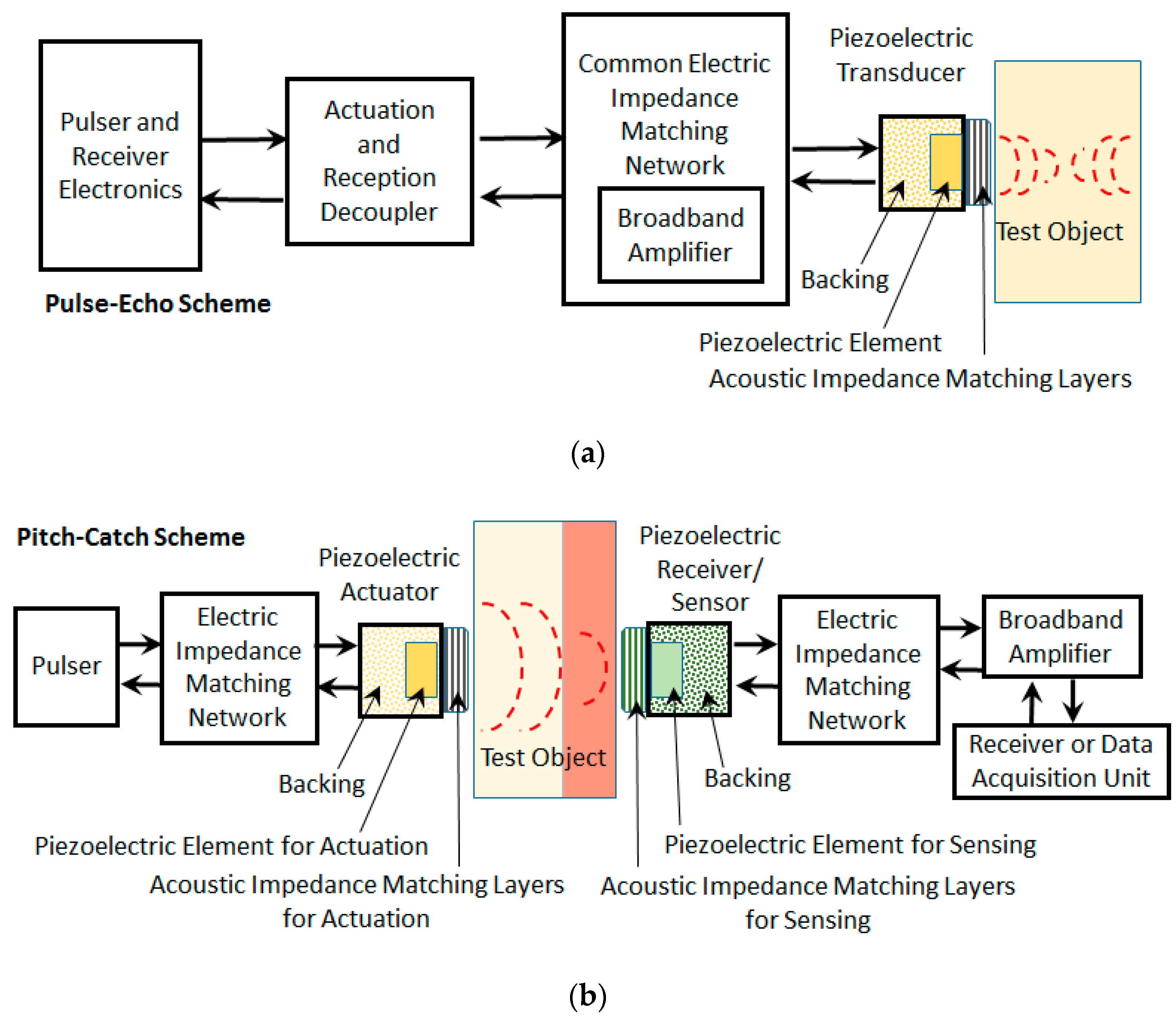
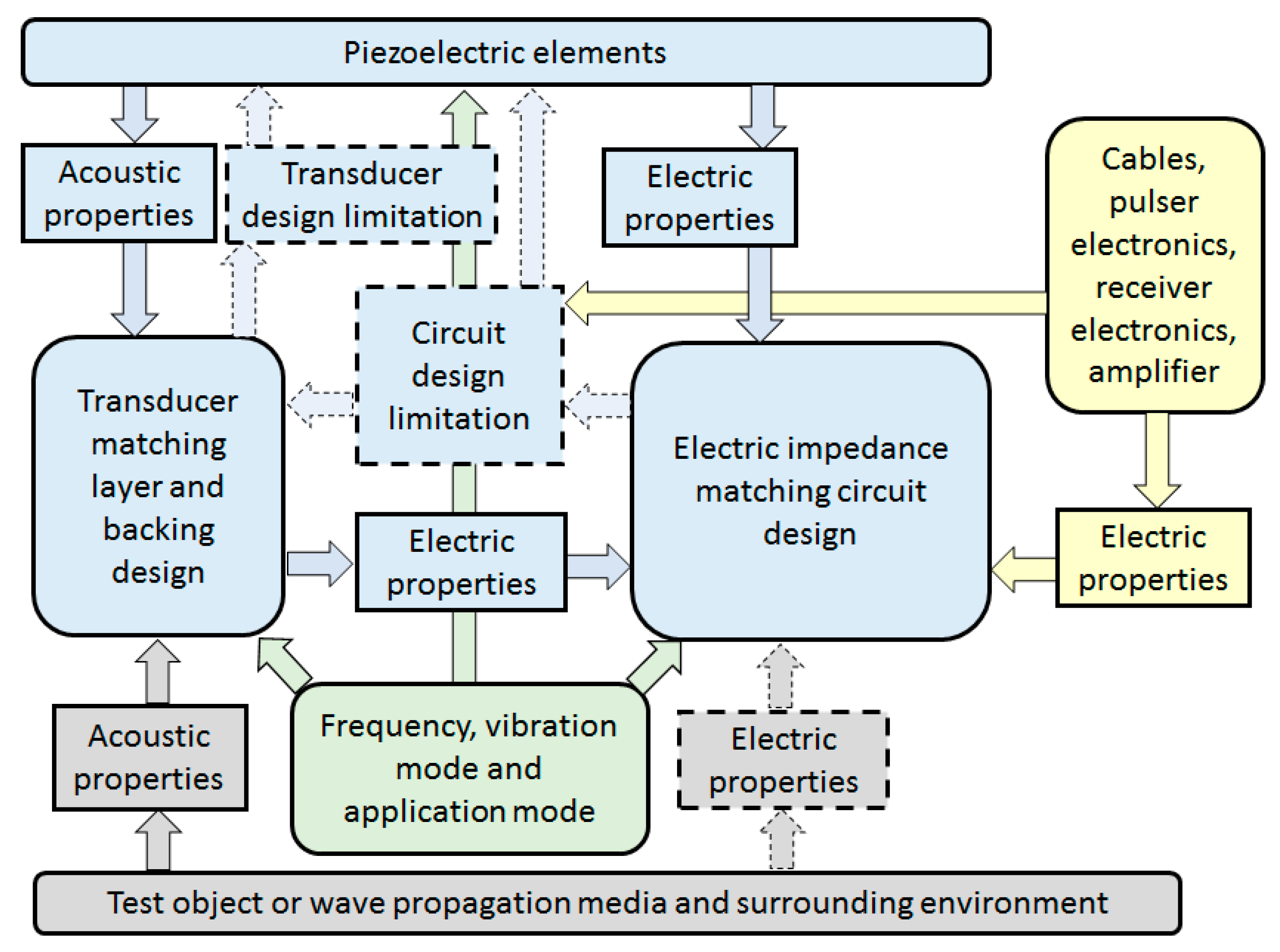
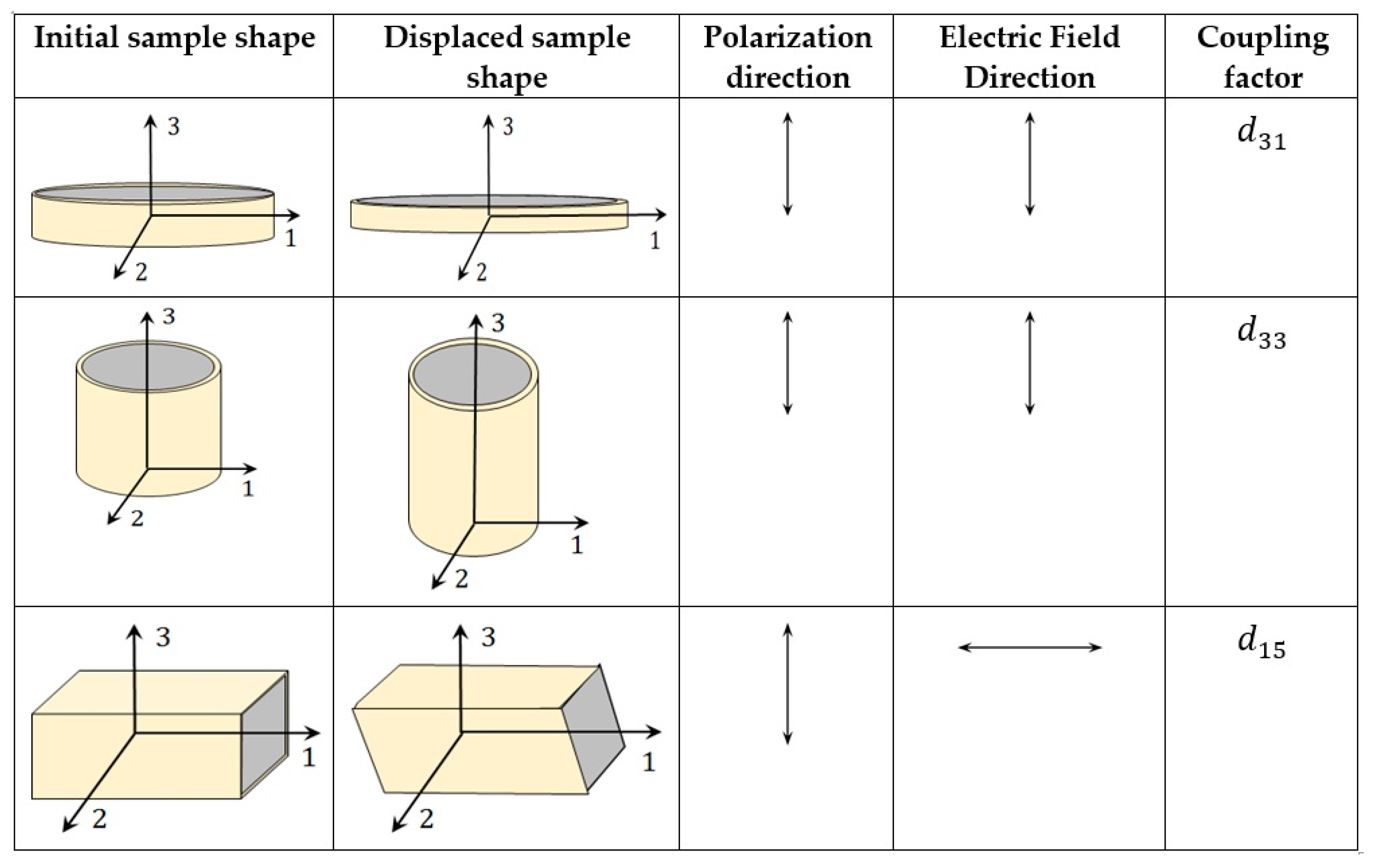


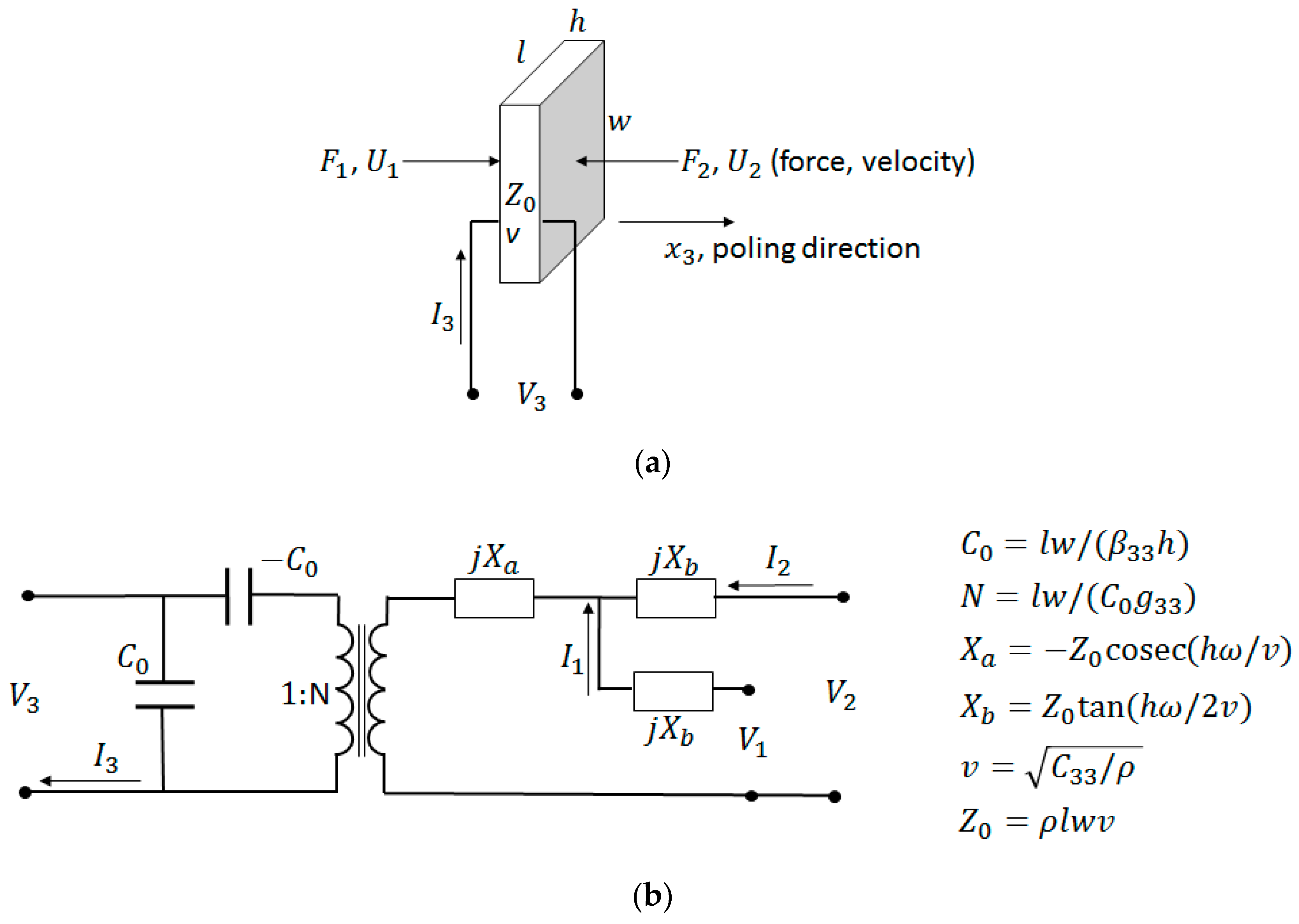
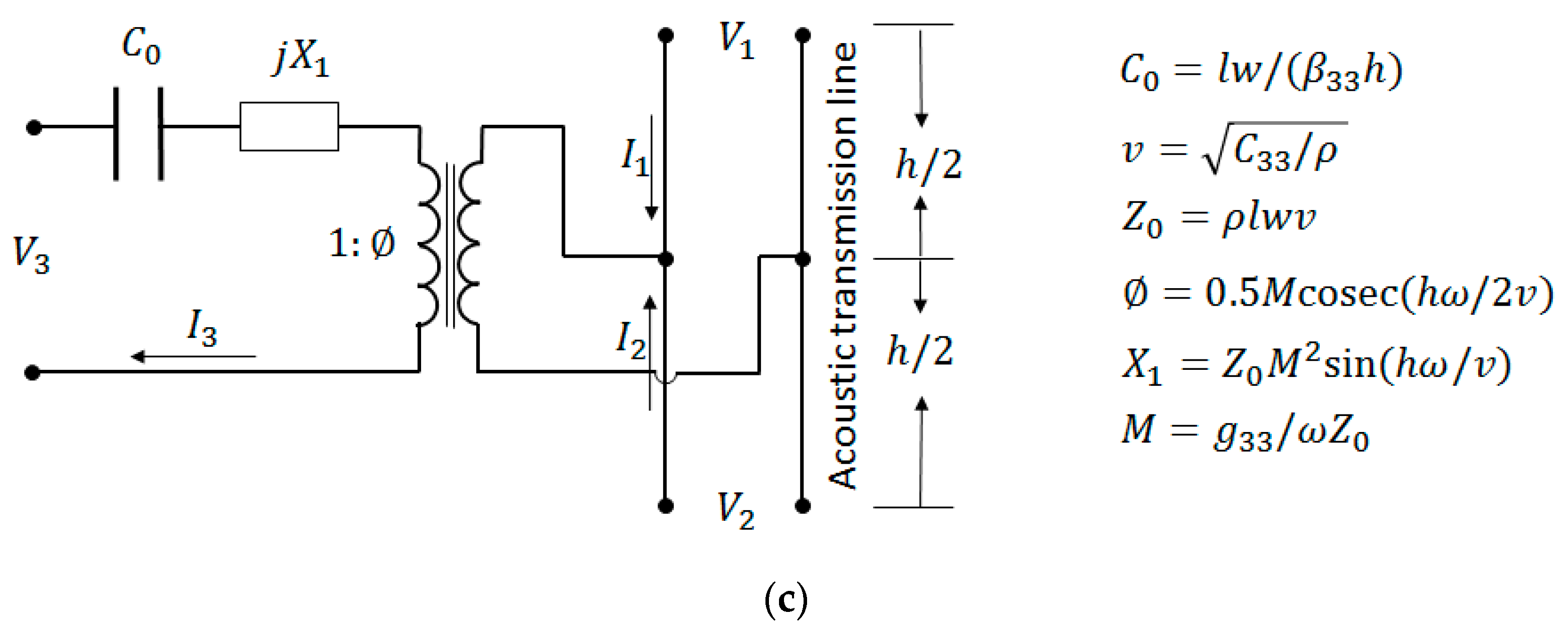
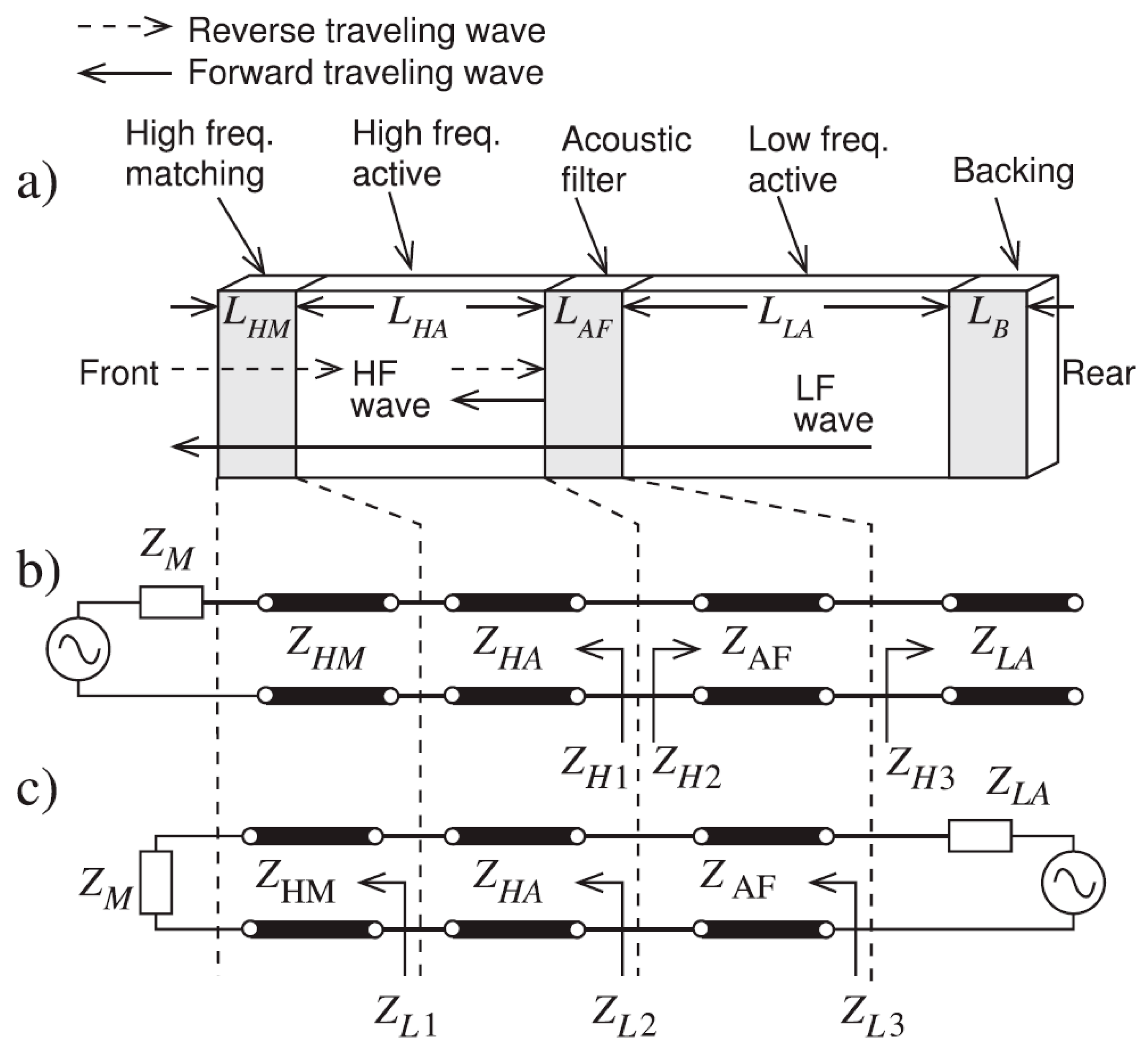
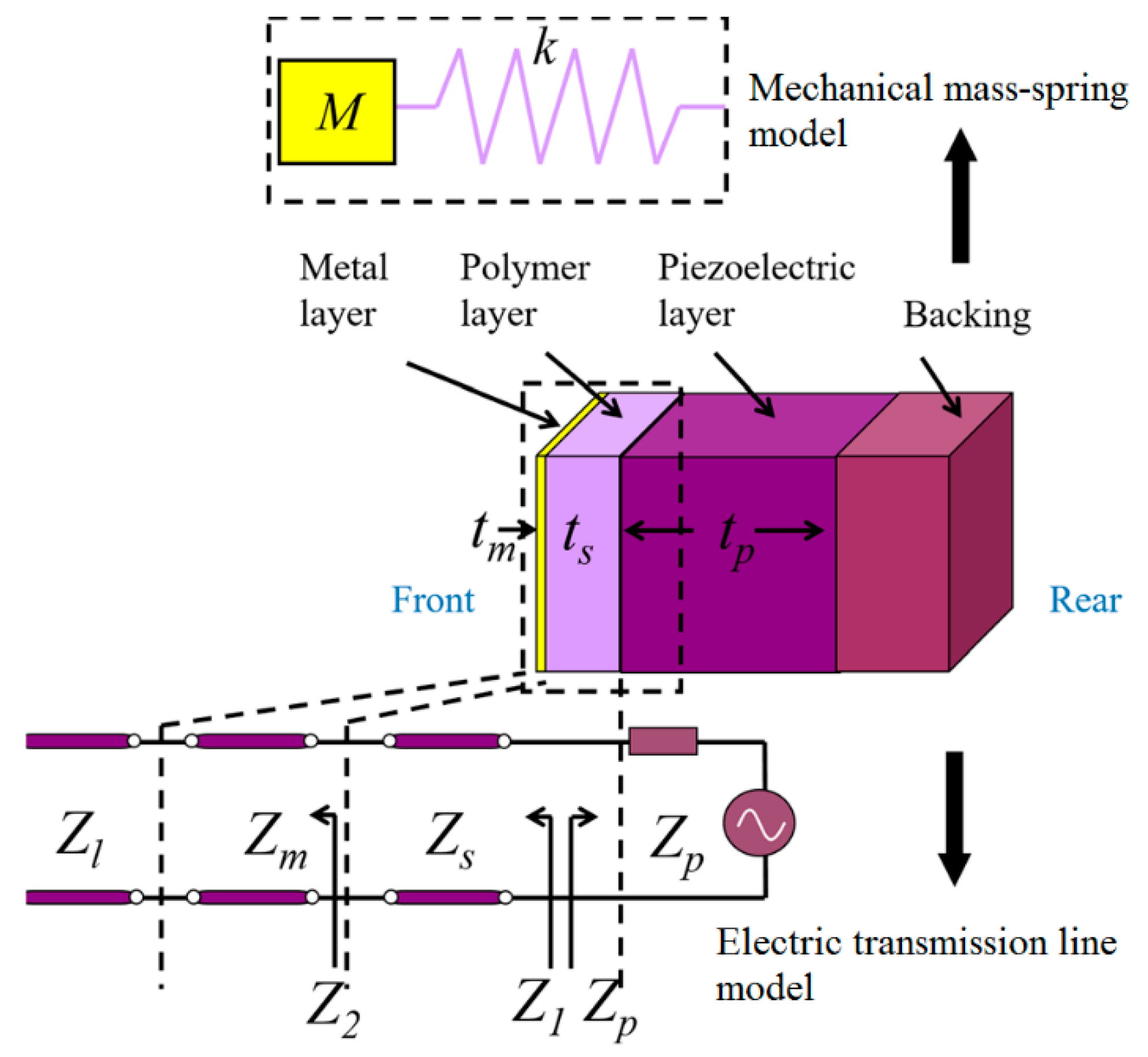
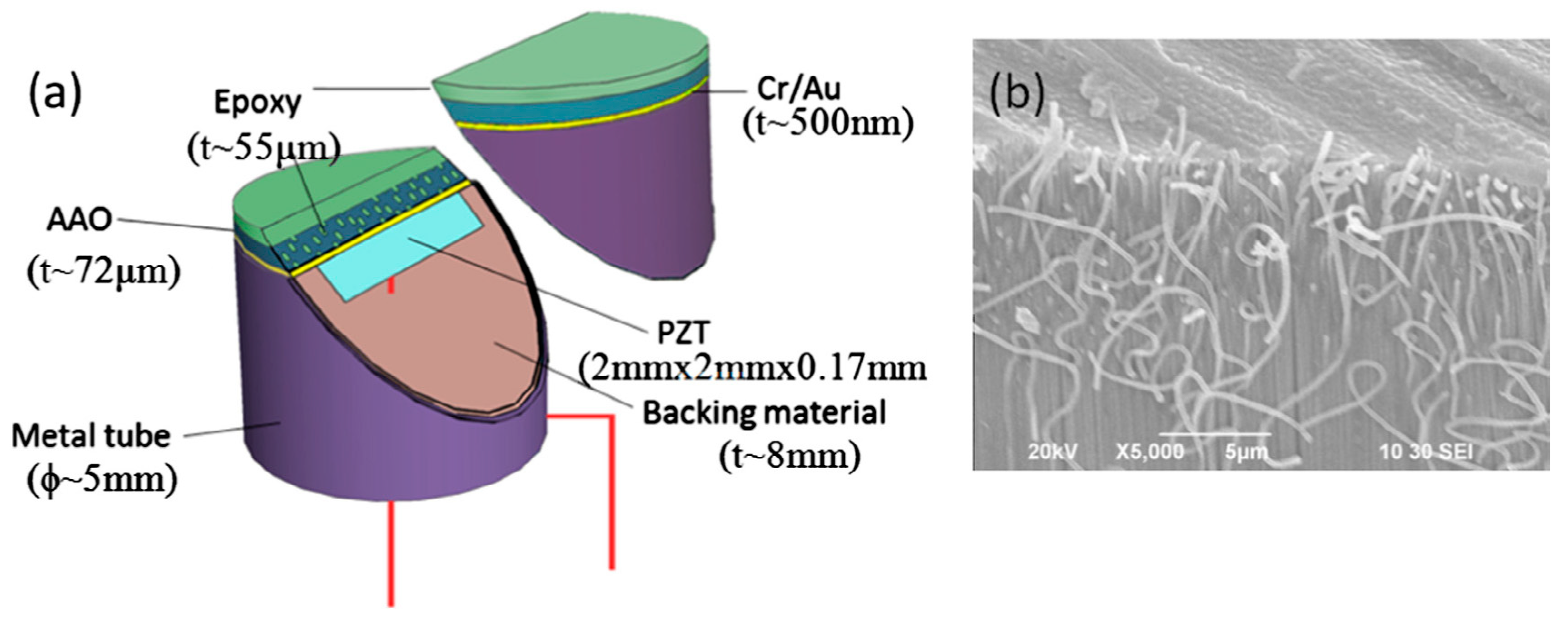
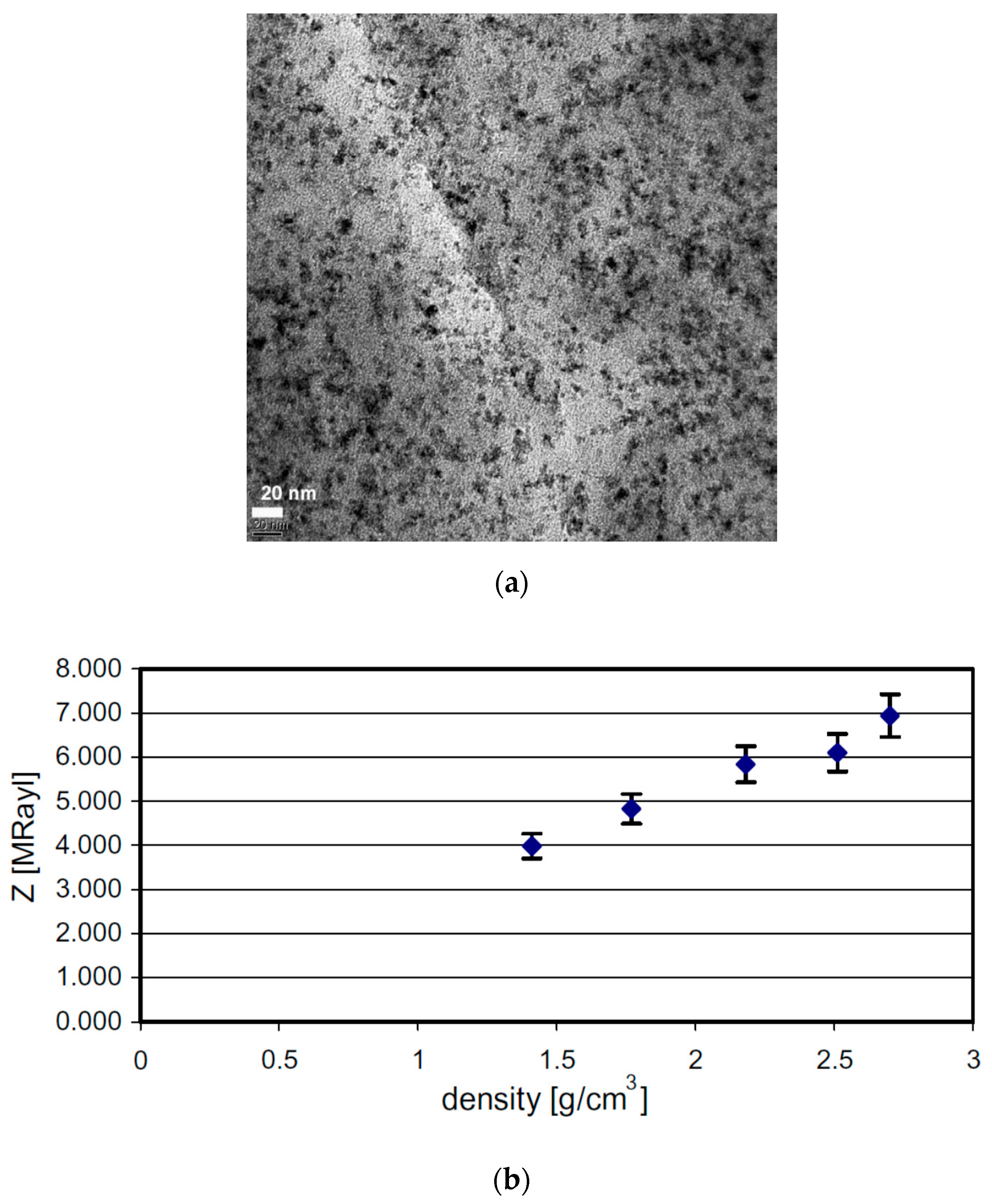
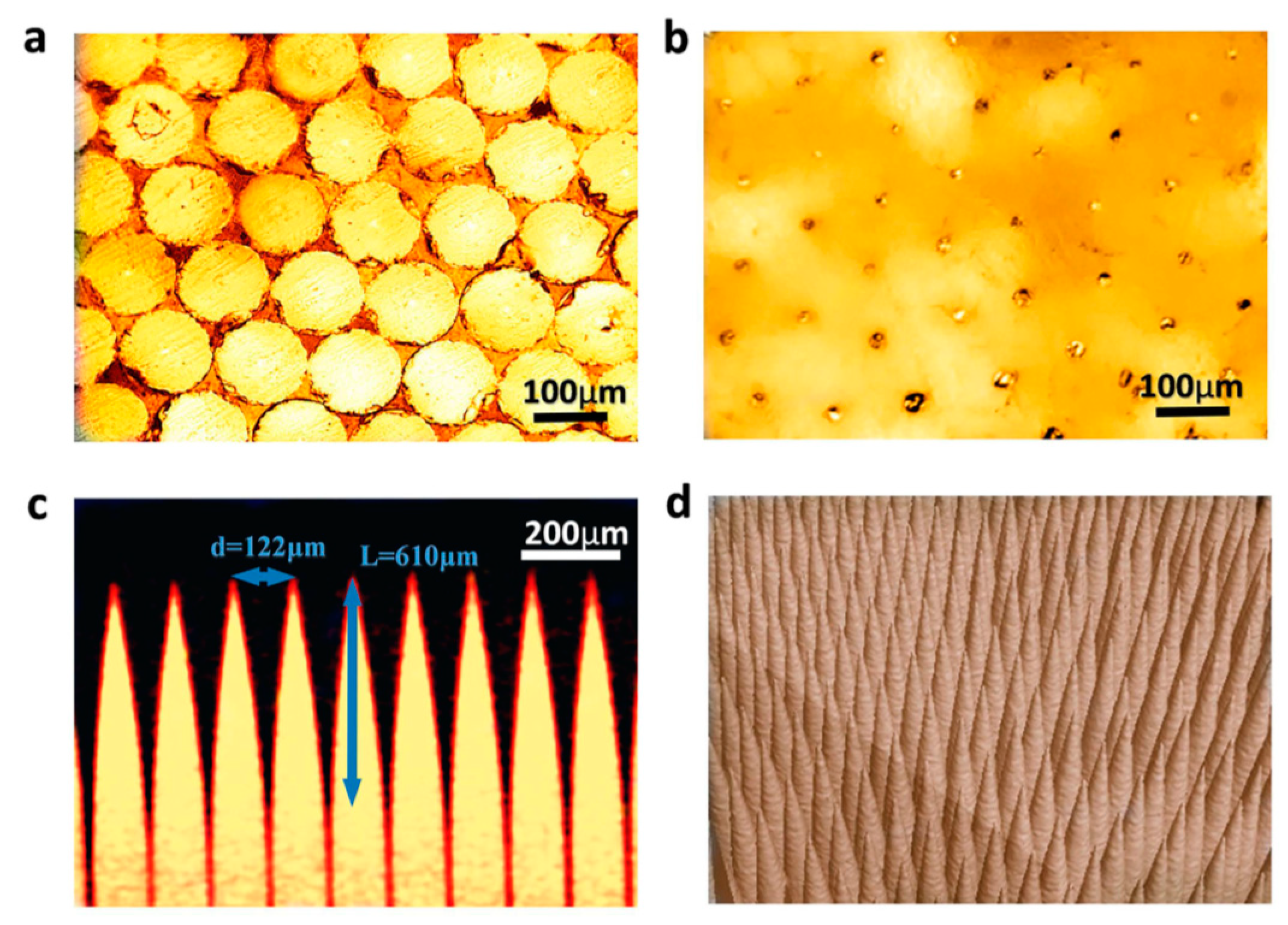
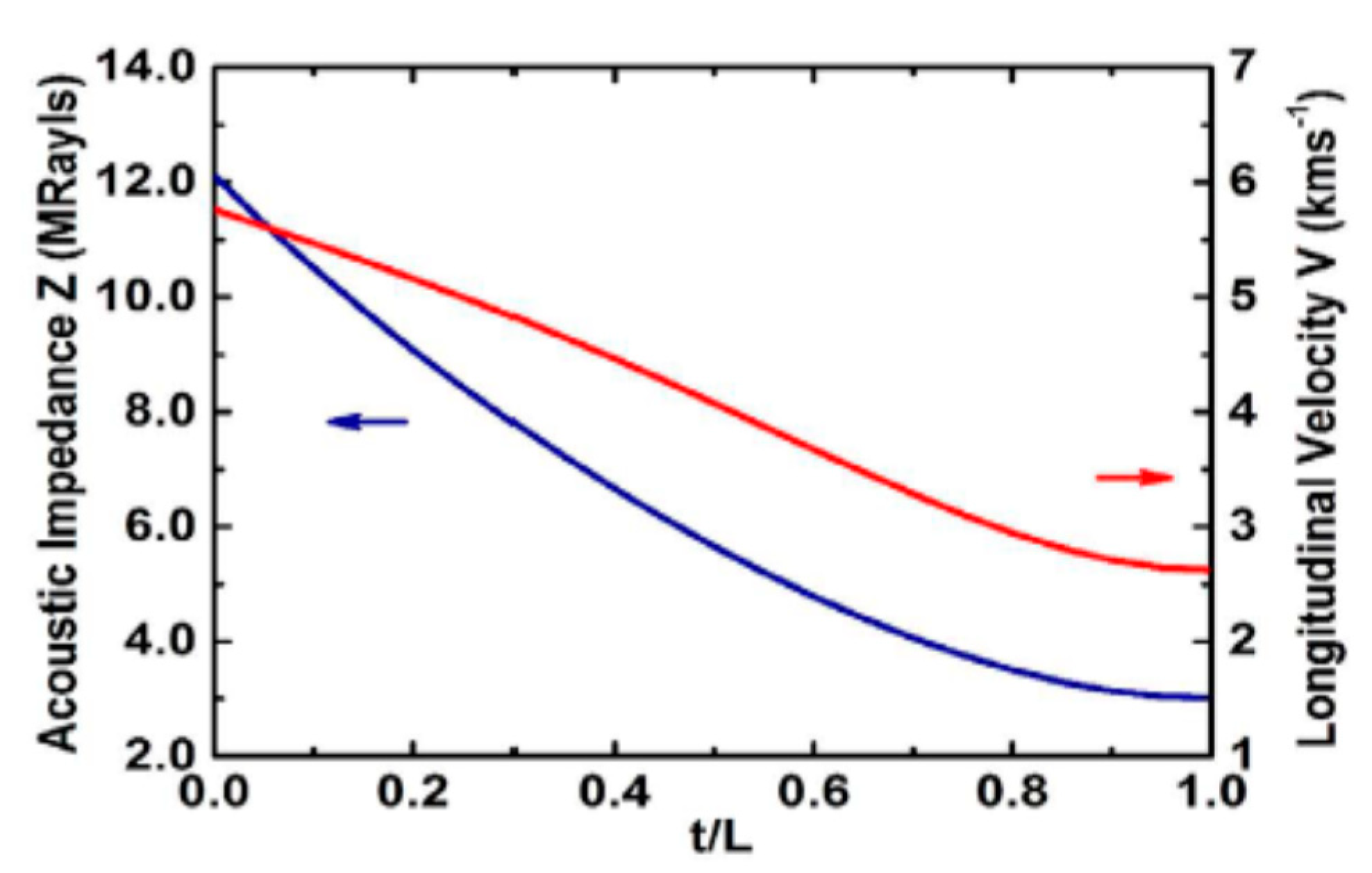
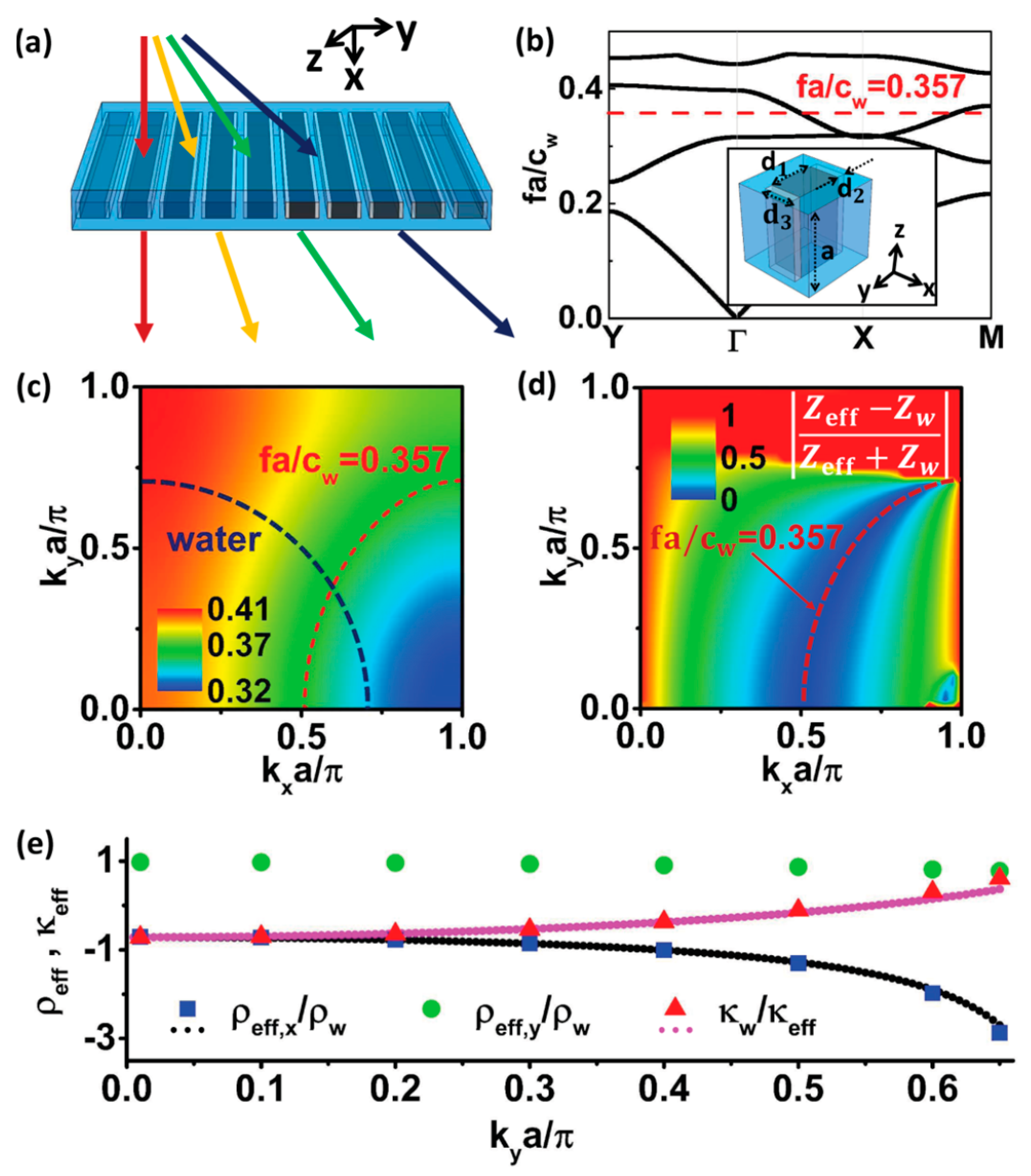
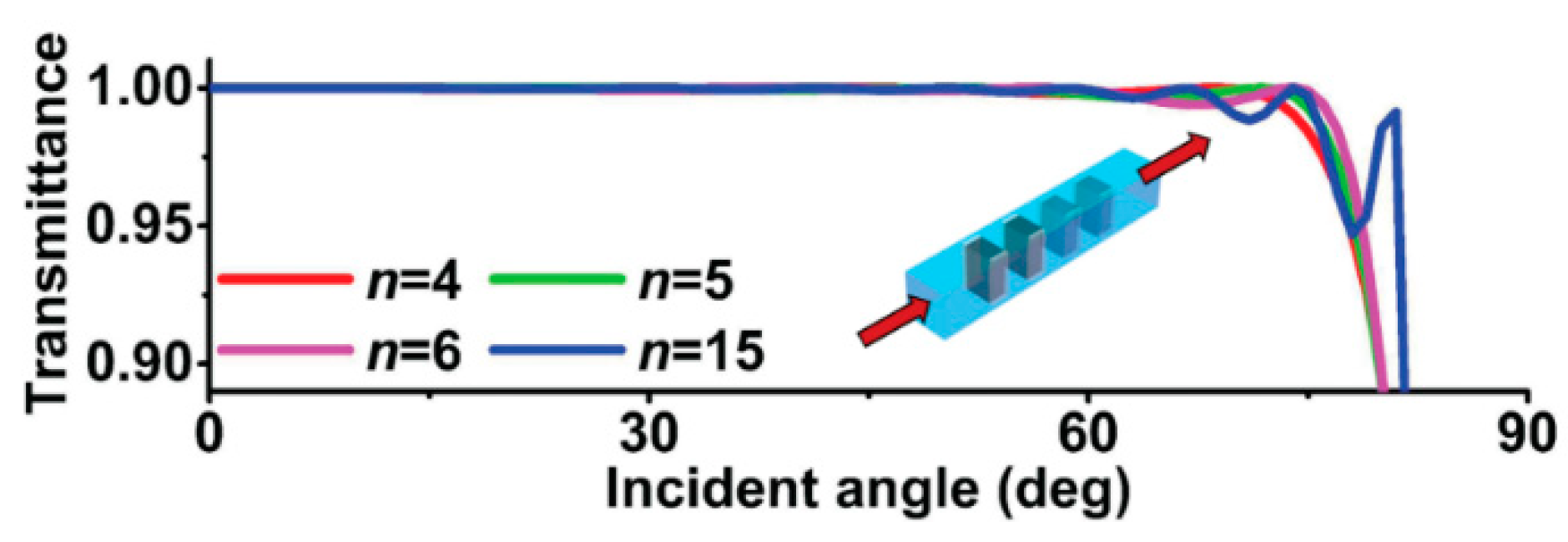
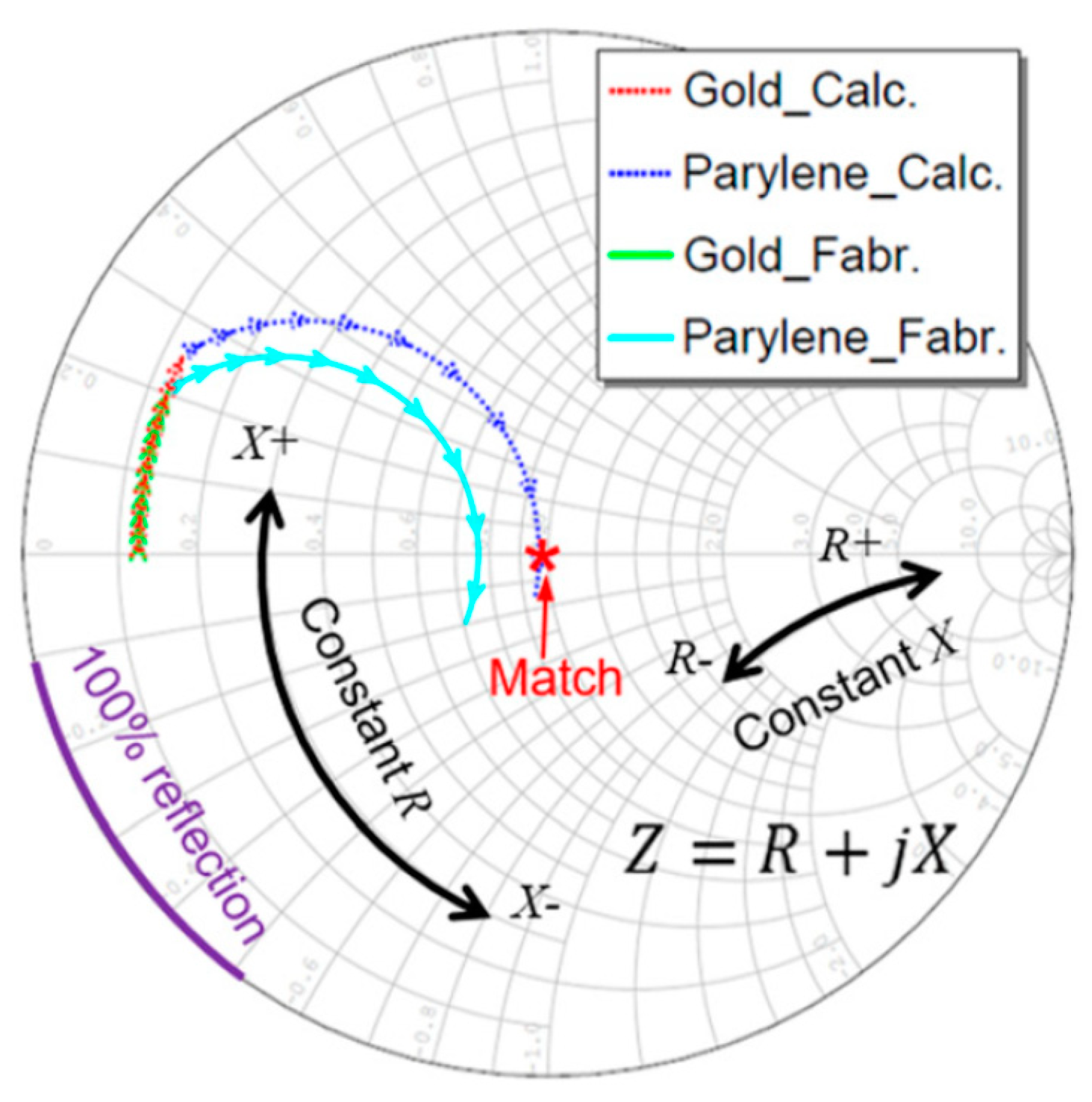
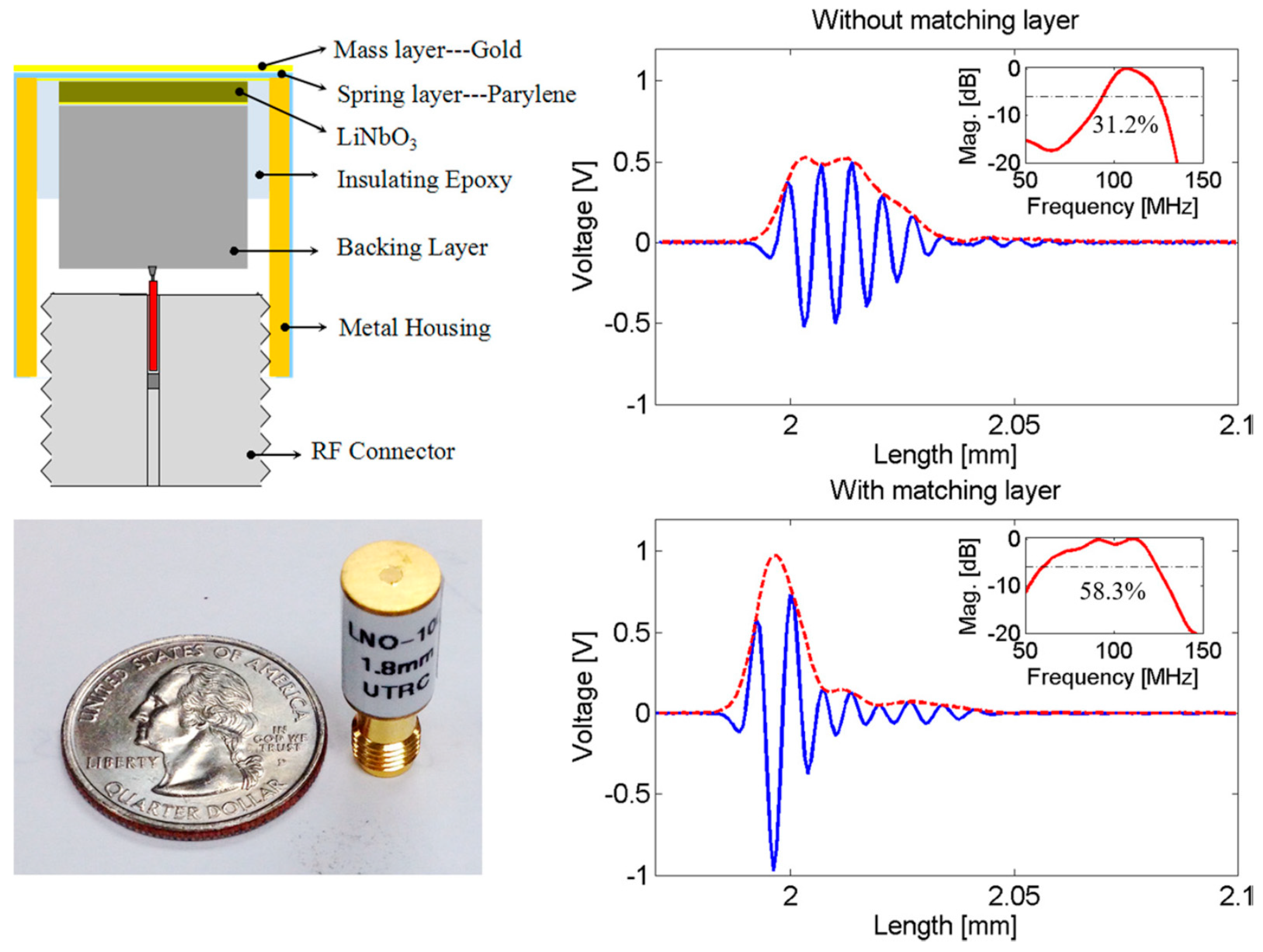
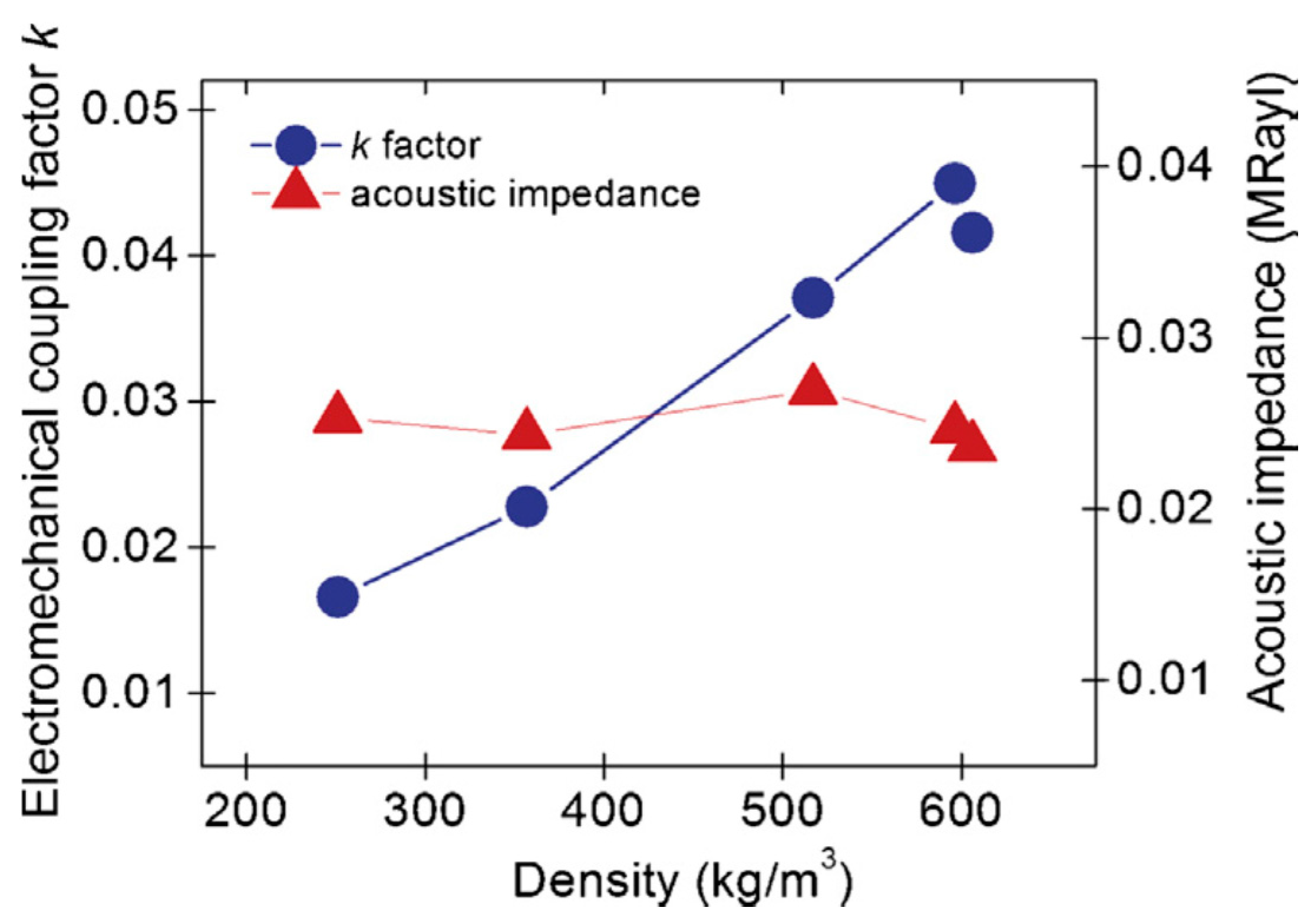


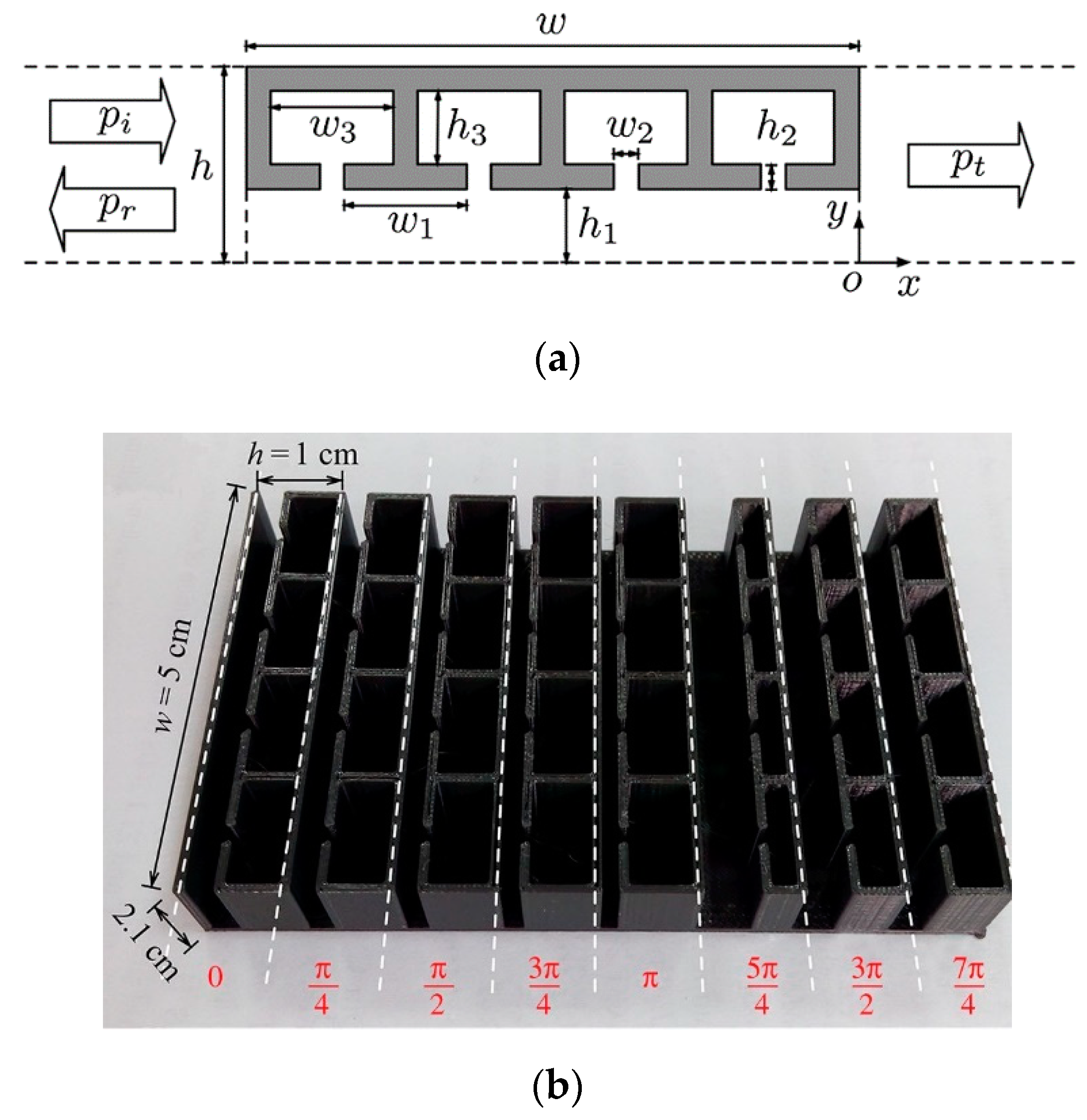

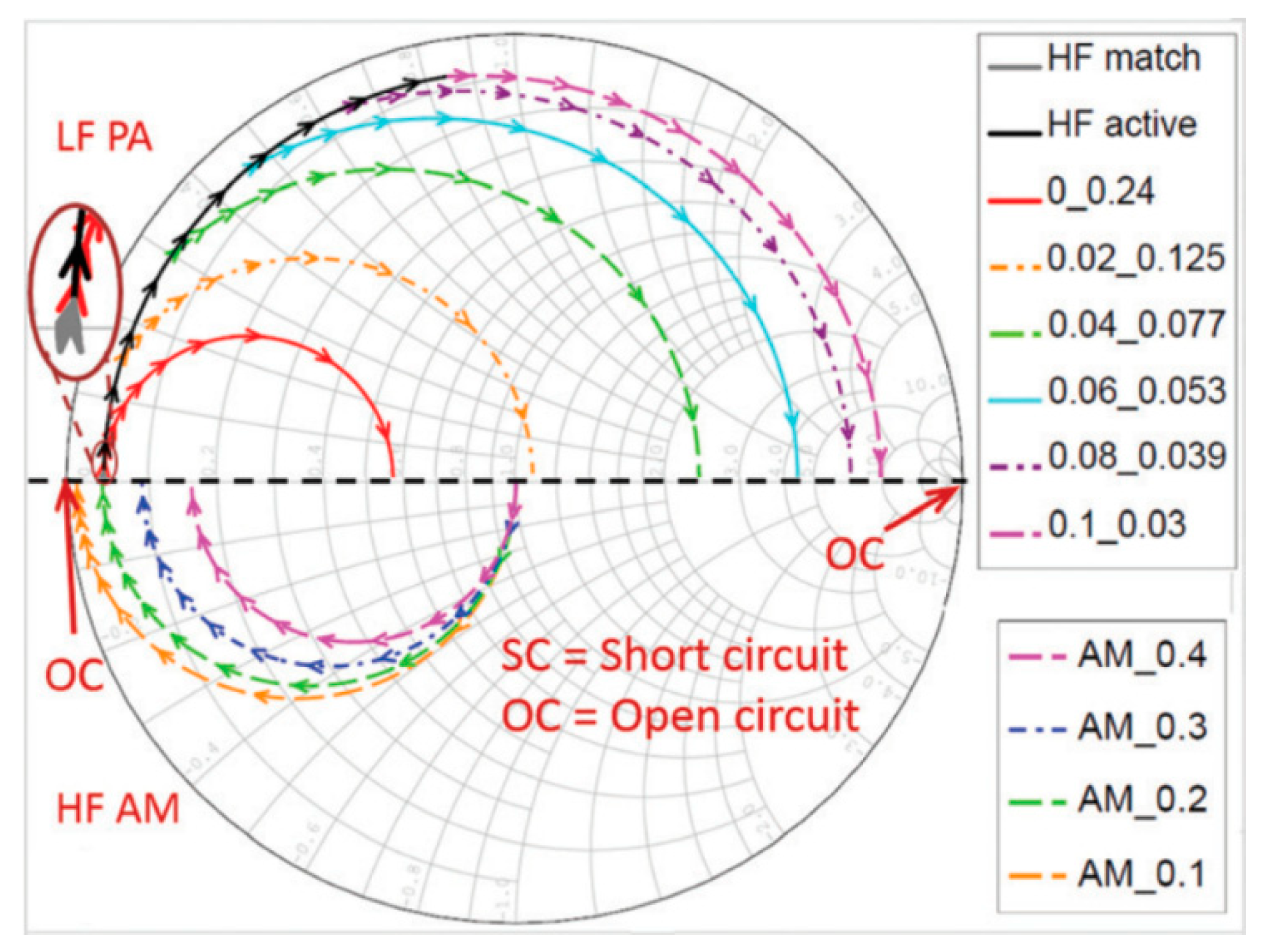



| Piezoceramic Lead Zirconate Titanate (Synthetic) [67,75,77,85,101,102] | Lead-Free Piezoceramics (Synthetic) | |||||||||
|---|---|---|---|---|---|---|---|---|---|---|
| Properties | PZT4 | PZT5A | PZT5H | PZT6B | PZT7A | PZT8 | BaTiO3 [85] | KNaNb2O6 [85] | LiNbO3 [85,103] | PMN–PT (33% PT) [67] |
| Curie Point (°C) | 325 | 365 | 200 | 350 | 350 | 300 | 115 | 420 | 1150 | 130 |
| (pC/N) | 285 | 374 | 593 | 71 | 153 | 225 | 190 | 127 | 6 | 5500 |
| (pC/N) | −122 | −171 | −265 | −27 | −60 | −97 | −78 | −51 | - | |
| (pC/N) | 495 | 585 | 130 | 360 | 330 | 260 | 306 | 69 | ||
| 1300 | 1700 | 460 | 425 | 1000 | 1700 | 495 | 25 | |||
| 0.70 | 0.71 | 0.75 | 0.37 | 0.67 | 0.64 | 0.50 | 0.60 | 0.23 | 0.94 | |
| −0.33 | −0.34 | 0.36 | −0.15 | −0.30 | −0.30 | 0.21 | −0.27 | - | ||
| 0.71 | 0.69 | 0.38 | 0.68 | 0.55 | 0.48 | −0.46 | 0.60 | |||
| (Vm-N) | 0.025 | 0.0166 | 0.0125 | |||||||
| (10−12 m2/N) | 15.5 | 18.8 | 9.35 | 13.9 | 13.5 | - | - | - | ||
| (10−12 m2/N) | 12.3 | 16.4 | 9.0 | 10.7 | 11.5 | - | - | - | ||
| 1470 | - | - | 39 | 680–800 | ||||||
| 635 | 830 | 1470 | 385 | 235 | 580 | - | - | - | 680–800 | |
| Mechanical Q | 75 | 65 | 32 | |||||||
| (kg/m3) | 7700 | 7700 | 7500 | 5400 | 4640 | 8060 | ||||
| (m/s) | 4600 | 4580 | 4000 | 7640 | 4610 | |||||
| (MRayl) | 36.15 | 30.00 | 34.35 | 30.00 | 32.00 | 30 | 34 | 37.15 | ||
| Properties | PVDF [74,113,117,118,119,121] | P(VDF-TrFE) [120,121] | Parylene-C [121] | -CN) APB/OPDA [121] |
|---|---|---|---|---|
| Curie Point (°C) | 160 | 115 | - | - |
| Max temp (°C) | 90 | 100 | - | 220 |
| (pC/N) | −13.6 | −33.5 | 2.0 | 5.3–16.5 |
| (pC/N) | 5.3 | 10.7 | - | - |
| (pC/N) | 1.5 | 10.1 | - | - |
| (pC/N) | −27 | −36.3 | - | - |
| (Vm-N) | −0.32 | −0.38 | - | - |
| (percent) | 4.4 | 6.2 | 0.02 | 0.048–0.15 |
| (percent) | 3 | - | - | - |
| [100] | 0.15–0.2 | 0.3 | - | - |
| (GPa) | 2.5–3.2 | 1.1–3 | 2.8 | 2–3 |
| (GN/m2) | 3.70 | 3.01 | - | - |
| (GN/m2) | 3.20 | 2.99 | - | - |
| (GN/m2) | 1.51 | 3.33 | - | - |
| (GN/m2) | 0.7 | 0.69 | - | - |
| 12 | 12 | 3.15 | 4 | |
| 6.9 | 7.40 | - | - | |
| 8.6 | 7.95 | - | - | |
| 7.6 | 7.90 | - | - | |
| Tan | 0.018 | 0.018 | - | 0.01 |
| Tan | 0.05 | 0.05 | 0.06 | 0.06 |
| [100] | 10 | 25 | - | - |
| (kg/m3) | 1760 | 1880 | 1100–1290 | 1420 |
| (m/s) | 2260 | 2400 | 2350 | - |
| (MRayl) | 20 | 4.51 | 2.58 | - |
| Properties | MFC [121,148,149] | PMN-0.29PT/Epoxy [121,150] | ZNo/SU-8 20% | BURPS [151] | Macrovoid [85] | Perforated [152] | Honeycomb [85] | Perforated [152] | Weave [85] | Laminate [85,153] |
|---|---|---|---|---|---|---|---|---|---|---|
| Connectivity | 1-3 | 1-3 | 0-3 | 3-3 | 3-0 | 0-3 | 3-1 | 3-2 | 2-3 | 2-2 |
| Filler | PZT | PMN-0.29PT | ZNo | PZT(50%) | Void | PZT | PZT | PZT | - | PZT (15–30%) |
| Matrix | Epoxy | Epoxy | SU-8 20% | Epoxy | PZT | Silicone rubber | Polymer | Epoxy | - | Epoxy |
| Max use temp (°C) | 130 | 130 | 180 | - | - | - | - | - | - | - |
| Elastic Constants (GPa) | = 30.34; = 15.86; = 5.52; = 0.31 | - | - | - | - | - | - | - | - | - |
| (pC/N) | 714 | - | - | 120 | 150 | 28.3 | 100 | 329 | 80 | 50 |
| (pC/N) | - | - | - | 27 | 30 | 32 | 30 | 128 | 65 | 16.6 |
| (pC/N) | 374 | 1200 | 5–8 | 160 | - | - | - | 290 | - | 410 to 440 |
| (pC/N) | 170 | - | 5 | - | - | - | - | - | - | −188 to −200 |
| (percent) | 0.53 | 0.9 | 0.07–0.12 | - | - | - | - | - | - | - |
| (percent) | 0.34 | - | 0.07 | - | - | - | - | - | - | - |
| 850 | 2000 | 7 | 500 | 560 | 100 | 400 | 290 | 140 | 340 | |
| (kg/m3) | 5440–7500 | 5000 | - | - | - | - | - | - | - | - |
| Material | Typical Function | (kg/m3) | (m/s) | Attenuation or Loss | |
|---|---|---|---|---|---|
| LiNbO3 Crystal | Active element | 7360 | 4688 | 34.5 | - |
| Quartz | Active element | 2650 | 5740 | 15.2 | - |
| PZT5A [100,161] | Active element | 7750 | 4350 | 33.7 | 0.02 (dB/cm.MHz) |
| PZT4 | Active element | - | - | 36.15 | - |
| PMN–PT | Active element | 8100 | 3950 | 32.0 | - |
| Parylene | Matching layer | 2350 | 1100 | 2.58 | - |
| Gold | Matching layer | 3240 | 19700 | 63.8 | - |
| Aluminium | Matching layer | 2700 | 6320 | 17 | - |
| Steel | Matching layer | 7700 | 5900 | 45 | - |
| Glass | Matching layer | 3000 | 5000 | 15 | - |
| Perspex | Matching layer | 1180 | 2730 | 3.2 | - |
| Polystrene | Matching layer | 1060 | 2350 | 2.5 | - |
| AAO–epoxy | Matching layer | 2745 | 3460 | 9.5 | - |
| HDPE | Matching layer | 951 | 2339 | 2.22 | 12.41 (Np/m) |
| Syntactic foam | Matching layer | 704 | 2486 | 1.75 | 41.3 (Np/m) |
| 2 µm Al2O3/Epotek 301 | Matching layer | 2300 | 2800 | 6.4 | 1.68 (dB/mm at 3.2 MHz) |
| Teflon | Matching layer | 2200 | 1390 | 2.97 | - |
| Polycarbonate | Matching layer | 1220 | 2300 | 2.75 | - |
| Acrylonitrile-butadiene-styrene | Matching layer | 1060 | 2510 | 2.68 | - |
| Polypropylene | Matching layer | 920 | 2740 | 2.4 | - |
| Polysulfone | Matching layer | 1240 | 2240 | 2.78 | - |
| Mylar | Matching layer | 1380 | 2540 | 3.00 | - |
| Epotek 301 | Lens/Epoxy | 1048 | 2640 | 2.8 | 1.04 (dB/mm at 3.2 MHz) |
| E-Solder 3022 | Conductive backing | 1850 | 3200 | 5.92 | 11.8 (dB/mm at 3.2 MHz) |
| Tungsten powder/µ bubbles/Epotek 301 | Backing layer | 3570 | 1820 | 6.5 | - |
| 5 µm Tungsten powder/micro bubbles/Epotek 301 | Heavy backing layer | 8925 | 1800 | 16.0 | 16 (dB/mm at 3.2 MHz) |
| Epoxy EPO-TEK 301 | Insulation | 2650 | 1150 | 3.05 | - |
| Water | Media | 997 | 1450–1498 | 1.445–1.5; 1.48 [155] | 0.002 (dB/cm.MHz) |
| Air (Rayl) | Media | 1.225 | 343 | 0.000420 | 1.64 (dB/cm.MHz) |
| Tissue (Blood) | Media | - | - | 1.66 | 0.15 (dB/cm.MHz) |
| Tissue (Fat) | Media | - | - | 1.38 | 0.6 (dB/cm.MHz) |
| Tissue (Bone) | Media | - | - | 7.75 | 2–15 (dB/cm.MHz) |
| Tissue (Skin) | Media | - | - | 1.99 | 9.2 (dB/cm.MHz) |
| Concrete [162] | Media | - | - | 8.36–11.3 | - |
| Transducer Type | Active Element | Acoustic Load | Matching Layer Material | Bandwidth | Loss | Ref | |
|---|---|---|---|---|---|---|---|
| Ultrasonic imaging (12 MHz) | Lead zirconate titanate piezo ceramic | Human tissue | AAO–epoxy 1-3 composite | 9.1 and 2.4 for 2 layers | 68% (−6 dB) | 2-way insertion −22.7 dB | [157] |
| Ultrasonic imaging (40 MHz) | LiNbO3 | Human tissue | alumina/polymer | 2.8 to 5.1 for single layer | 35% (−6 dB) | 15 dB/mm | [237] |
| Medical ultrasound (100 MHz) | Zinc oxide layer | Water | cerium oxide/polymer | 4.0 to 7.0 for single layer | (signal enhanced by 100%) | 0.5 dB/µm | [238] |
| Medical ultrasound (>50 MHz) | PZT piezoceramics | Human tissue | Silicon oxide colloidal/polymer | 4.4 to 5.8 for single layer | - | - | [239] |
| Ultrasonic imaging (1 GHz) | Silicon | Water | Su8/TiO2 | 3.0 to 6.0 | - | 0.5 dB/µm | [240] |
| Medical ultrasound (15 MHz) | PZT piezoceramics | Human tissue | silicon-polymer 1-3 composites | 5.54 to 6.32 | 50% (−6 dB) | - | [241] |
© 2020 by the author. Licensee MDPI, Basel, Switzerland. This article is an open access article distributed under the terms and conditions of the Creative Commons Attribution (CC BY) license (http://creativecommons.org/licenses/by/4.0/).
Share and Cite
Rathod, V.T. A Review of Acoustic Impedance Matching Techniques for Piezoelectric Sensors and Transducers. Sensors 2020, 20, 4051. https://doi.org/10.3390/s20144051
Rathod VT. A Review of Acoustic Impedance Matching Techniques for Piezoelectric Sensors and Transducers. Sensors. 2020; 20(14):4051. https://doi.org/10.3390/s20144051
Chicago/Turabian StyleRathod, Vivek T. 2020. "A Review of Acoustic Impedance Matching Techniques for Piezoelectric Sensors and Transducers" Sensors 20, no. 14: 4051. https://doi.org/10.3390/s20144051
APA StyleRathod, V. T. (2020). A Review of Acoustic Impedance Matching Techniques for Piezoelectric Sensors and Transducers. Sensors, 20(14), 4051. https://doi.org/10.3390/s20144051




